|

|

Festspielhaus
|

Haus Wahnfried
|

|

|

The great Steward Houston Chamberlain
|
|

|

Winifred Wagner
|

Der Führer, Wagner's greatest fan
|

|

|

Wotan
|
|

Festspielhaus front office
|

Visit by der Führer
|

Bayreuth
|

|

|

Grand opening of opera season
|
|
Book Bayreuth die Stadt Richard Wagners (Item ART 17-15; WAG 1-7)
|
| DESCRIPTION: This is a great softcover book comprising 80 pages of beautiful pictures and text with a concise history of Bayreuth. It freatures the Festspielhaus and the world’s greatest composer (in my opinion), Richard Wagner. The book was published in 1942. So many of the pages detail Adolf Hitler’s infatuation with my hero and Winifred Wagner, a lady that the Führer vastly admired; the feeling was mutual. Winifred was steadfast in her loyalty to Adolf Hitler and when the Americans at the “show trial” at Nuremberg tried to get her to deny him, she outright refused and praised him. The book is filled with great pictures of various scenic props and staging of the operas plus pictures of the actors who had starring roles in the elaborate and thrilling presentations. There are also charming pictures of Wagner and his beloved wife, Cosima. There are also great pictures of Haus Wahnfried and the museum. The pictures are exemplary sharp and clear. This book personifies the great glory of the Wagnerian mythos. It measures 9 x 12 inches. At the rear of the book are about 15 pages of advertisements of many types; from travel inducements to ads for fine wines, hotels, the Nymphenburg Porcelain Company, banks, restaurants, etc., and even includes an invitation to the Nuremberg Party Rally (Reichparteitag). This is a very important volume that depicts in wonderful detail the wonderful cultural pursuits of the Third Reich.
PRICE:$265.00 This is an ultra-rare book!
|
|
|
Most Incredible Third Reich Tapestry (Item ART 17-16; HH Tapestry; SS 36-15)
|
DESCRIPTION: Here is one of our greatest offers yet when it comes to art of the Third Reich. This is a weaver’s state-of-the-art masterpiece, indeed. There was no more a valued article to the Third Reich mythos than the great tapestries. They were meant to convey thoughts of grandeur, artistic aplomb, and strength. We have owned the SS-Ahenenerbe tapestry and the SS-Lebensborn tapestry in the past. Both were bought by private collectors and still are shown in their collections. Those were extremely important and practically priceless today, but for sheer beauty, the tapestry we offer now is many times as beautiful and has much meaning also. It celebrates the usage of the swastika and the Eichenblatt (oak leaf) in the central design. Along the edges you can see the Greek key pattern employing repetitive swastikas, while the eight large Hakenkreuzen in the central motif are done in red-velvet material, and in the four corners are four ”Sonnenrad” (sun wheels {multiarmed swastikas}). All this is for the purpose of bringing to the viewer the visage and meaning of the heritage of the swastika and how it evolved from the ancient Teutonic cult of sun worship. The oak leaves and acorns are to illustrate the tradition of the Hellig (sacred oak) that was so prodigiously important to these ancients. In the Third Reich these sacred symbols were being brought back to life and no better instruments could be used than the tapestry to convey the message, especially a tapestry (Wandteppich) that commands immediate attentive admiration through its beauty and boldness. They certainly was a statement!
We at Germania International have brought to the field of collecting the finest and most historically important N.S. items imaginable, but it seems we have even outdone ourselves this time. Now for some interesting background. We have had to put on our Sherlock Holmes cap to investigate this one and call on some of our greatest advisors who are somewhat walking encyclopedias of the Third Reich. One of our advisors, Mr. Johnston, was the man who managed to find and to purchase in the past both the SS-Ahnenerbe tapestry and the SS-Lebensborn tapestry and he did intensive and exhaustive research on both of them. He was last seen to be working on an article on tapestries and their strategic importance to the Reich of Adolf Hitler. The Ahnenerbe tapestry was designed by  -Oberführer and Professor Carl Diebitsch, the founder of the SS Allach porcelain firm. The actual handwork was performed by Elsie Seifert, his sister in Munich, and because of the style of the work, Mr. Johnston believes this Hakenkreuz tapestry was also accomplished by Diebitsch and Frau Seifert. Here you can read a narrative of the relationship between Carl Diebitsch and his sister Elsie Seifert in regards to the tapestry. The article also visits the means in which the tapestry was obtained as well as some detail on the tapestry, itself. Our advisor, Mr. Johnston, takes issue with that part of the tapestry’s history concerning its initial reported location as stated here: “This piece originally hung in the Reichstag, but was removed to Himmler's residence after a fire which destroyed a similar piece.” First, Mr. Johnston is sure the tapestries never hung in the Reichstag. From sources in Germany, he found out that the three-tapestry set that this one was part of hung in the Berchtesgaden Reichskanzlei (the “small” Reichskanzlei). This was the official N.S. chancellery used by the N.S. government and Adolf Hitler for state business when the Führer was in the Berchtesgaden/Obersalzberg area. He was never far away from his work. The Reichskanzlei building in the beautiful Alps was another gorgeous structure like the Platterhof hotel; history-hating government vandals of the lowest order razed the latter building. Thank goodness, the Kanzlei building was spared when it was purchased by a private buyer and now has national-landmark status. Mr. Johnston visited there in 1970 and the beautiful red-marble walls would certainly have been particularly conducive to hanging these wonderful tapestries in the foyer also, considering that all trim including the railings and doorway entrances were trimmed in golden hues. If part of the building was destroyed in a fire, we don’t know; if the other two tapestries were removed to Himmler’s home, that also is not known for sure. Himmler maintained a home in Schönau for his mistress Hedwig Potthast. His other home was in Gmund am Tegernsee and this is the most likely place that he would have had them and this would have been a logical place indeed. We know that the huge, wooden chair that you see at Item HH Great Chair on our site was once in that place. These chairs were presented by Karl Maria Willigut to be placed at the SS Wewelsburg Castle, but Himmler was so enamored of them that he had them shipped to his Gmund home. Therefore, it is much within reason that he would have snatched up the tapestries for his residence as well. I know I would have!!! -Oberführer and Professor Carl Diebitsch, the founder of the SS Allach porcelain firm. The actual handwork was performed by Elsie Seifert, his sister in Munich, and because of the style of the work, Mr. Johnston believes this Hakenkreuz tapestry was also accomplished by Diebitsch and Frau Seifert. Here you can read a narrative of the relationship between Carl Diebitsch and his sister Elsie Seifert in regards to the tapestry. The article also visits the means in which the tapestry was obtained as well as some detail on the tapestry, itself. Our advisor, Mr. Johnston, takes issue with that part of the tapestry’s history concerning its initial reported location as stated here: “This piece originally hung in the Reichstag, but was removed to Himmler's residence after a fire which destroyed a similar piece.” First, Mr. Johnston is sure the tapestries never hung in the Reichstag. From sources in Germany, he found out that the three-tapestry set that this one was part of hung in the Berchtesgaden Reichskanzlei (the “small” Reichskanzlei). This was the official N.S. chancellery used by the N.S. government and Adolf Hitler for state business when the Führer was in the Berchtesgaden/Obersalzberg area. He was never far away from his work. The Reichskanzlei building in the beautiful Alps was another gorgeous structure like the Platterhof hotel; history-hating government vandals of the lowest order razed the latter building. Thank goodness, the Kanzlei building was spared when it was purchased by a private buyer and now has national-landmark status. Mr. Johnston visited there in 1970 and the beautiful red-marble walls would certainly have been particularly conducive to hanging these wonderful tapestries in the foyer also, considering that all trim including the railings and doorway entrances were trimmed in golden hues. If part of the building was destroyed in a fire, we don’t know; if the other two tapestries were removed to Himmler’s home, that also is not known for sure. Himmler maintained a home in Schönau for his mistress Hedwig Potthast. His other home was in Gmund am Tegernsee and this is the most likely place that he would have had them and this would have been a logical place indeed. We know that the huge, wooden chair that you see at Item HH Great Chair on our site was once in that place. These chairs were presented by Karl Maria Willigut to be placed at the SS Wewelsburg Castle, but Himmler was so enamored of them that he had them shipped to his Gmund home. Therefore, it is much within reason that he would have snatched up the tapestries for his residence as well. I know I would have!!!
Now! The other tapestry was offered up for auction in December of 2009, by Affiliated Auctions and Realty in Florida. From this link you can view the details of the auction. The reserve price was exceedingly high; not that the tapestry is not worth it—even more—, but it was the economy that worked against it and as far as we know, it never sold at auction. The reserve price was set at $150,000 and the estimate shown at the auction house was listed at $150,000 to $250,000. We do not know where that tapestry ended up, but images show some serious damage to it. Well, I can say when viewed it certainly looks like it merits the price range stated at the auction site, but keep in mind that the one we offer is in perfect condition and has all four golden tassels. It has been an adventure indeed. It seems the man who inherited it from the 101st veteran saw the other one being offered up for auction and decided to put his (now ours) up for sale. We negotiated with him after he contacted us and we purchased it. We were and are thrilled to own it, even if for a short time; it certainly is a prize museum piece extraordinaire! Nothing, absolutely nothing, that we have ever seen in tapestries or in fact general Third Reich art can start to compare for sheer beauty and importance. If you go to the site at the link at the beginning of this paragraph it will take you to a Paul Fraser Collectibles Newsletter. Note in the image there is some damage in the bottom left-hand corner of the one they offered and the tassels do not show. Did it have any? *Recently, it was revealed that indeed the tassels on thiers were missing. Also, this image does not even start to show the glorious deep, golden color that the piece demonstrates. The tapestry was also shown in Thomas Johnson’s book World War II German War Booty published in 1984. The tapestry is on page 66.
The piece we have is huge and probably weighs about 45 pounds and it is 137 inches long by 77 inches wide “Big” and is difficult for us to hang up for photographing. It has no mounting-rod arrangement or mounting rings nor is there an open sleeve to run a rod through. However, there is a long flap at the top and we believe this flap would be folded over a rod or wall ending and the tapestry would just naturally flow downward and hold its position. *See this flap in the pictures provided. Without providing for the flap, the decorated portion of the tapestry is 98 inches long. This is an ingenious method because other tapestries that suspend from mounting hooks tend to wrinkle and bulge when hung because of the gravitational pull at the extremities. This one would hang like the finest of draperies in a royal palace. So far, we have only the image that the seller sent us showing the piece hanging from his home balcony. We will, however, endeavor to get better images and present them later. We are convinced that this is a Diebitsch/Seifert art creation and it couldn’t get better than that!
PRICE: Price on Request; Serious inquiries only, please.
|
>
|
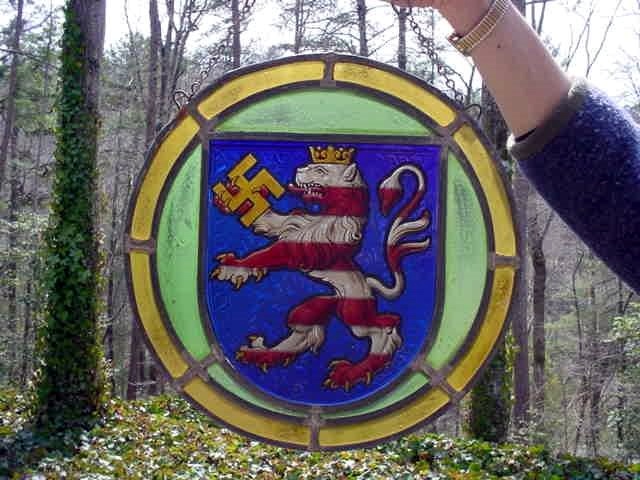
Note for size perspective the relationship to my arm |
|

|

|

|
<

The modern Thüringen crest;
not nearly as brave as ours
|
|

Gauleiter Fritz Wächtler
|

Gauleiter Fritz Wächtler; educator, NSDAP official
|

Wächtler with local teachers
|
|
Stained-Glass Thüringen Lion Window Hanging Having Belonged to NSDAP Gauleiter Fritz Wächtler (Item ART 17-16a; NSD 20-10; PERS 5-2)
|
DESCRIPTION: Stained-glass art goes back more than a thousand years. The name for this particular piece is Opalescent window art and actually it was originally an ancient art form from Munich and usually depicted religious themes. In Germany, a stained-glass window hanging as we offer here would be referred to as a Buntglas Fenster. Many years ago, Mr. Johnston, our historical advisor, lived in New York and was engaged for many years in the procurement and sales of war relics. He always had “the best”! There came a time that he approached a veteran or the vet approached him and told him that he had two ’Nazi’ stained-glass windows and was willing to sell them and several other items he had brought back (looted) from Germany. It turned out that from extrapolation of some letters and postcards that he said he took from the same estate that it was then loomed evident after subsequent research that here revealed was the Gauleiter of eastern Bavaria of Gau Bayreuth and that all the items were from his former office or home and that region. Wächtler also held the honorary rank of  -Obergruppenführer and Reich Defense Commissioner of Bayreuth. He had originally trained as a primary-school teacher and had the great honor bestowed upon him of being appointed the head of the Socialist Teachers League NSLB in 1935. He proved to be an able organizer and after the death of the first Gauleiter of the Bayreuth area, Hans Schemm, who died in an airplane crash, Wächtler was appointed his successor and until 1938 also served as the mayor of Bayreuth. -Obergruppenführer and Reich Defense Commissioner of Bayreuth. He had originally trained as a primary-school teacher and had the great honor bestowed upon him of being appointed the head of the Socialist Teachers League NSLB in 1935. He proved to be an able organizer and after the death of the first Gauleiter of the Bayreuth area, Hans Schemm, who died in an airplane crash, Wächtler was appointed his successor and until 1938 also served as the mayor of Bayreuth.
The glass window hanging
This magnificent piece of the glaser’s art depicts the arms of Thüringen. We wondered about this as Bayreuth was his official home and his workplace. Why Thüringen? Then it came to us! Wächtler was born in 1891, in Triebes Thüringen and it would have been understandably nostalgic to have this beautiful reminder of his ‘Heimat’ in his personal window. After joining the Nazi Party as member 35,313 in April 1926, he became its founding local group leader in his hometown of Triebes. He was elected as a member of the Bavarian Landtag and appointed deputy Gauleiter for the district of Thuringia. From August 1932, Wächtler served as education minister in the cabinet of the Minister President of Thüringen Fritz Saukel. Following the 1933 victory of the NSDAP until December 1935, Wächtler held the post of interior Minister of Thuringia and he also became a member of the Reichstag in Berlin. There is a controversy over his death. Some internet blogs say he was executed on the orders of Martin Bormann because he left the city of Bayreuth with his staff as American tanks approached. Bormann had ordered that all Gauleiters, Kreisleiters, and other NSDAP political leaders were to fight to the death in their districts. With the city in ruins and only 200 irregular defenders left, Wächtler left and set up offices in Waldmünchen in the southern part of the Gau. Some say he was executed by his own deputy, Ludwig Ruckdeschel, on orders from Bormann (Cause: desertion). Later evidence provides the more likely story that he was killed in an American bombing raid that followed. When Mr. Johnston bought this beautiful stained-glass window, hanging there actually was another one with it and that one was very impressive as well with the Coburg Honor Badge as its central design. This badge shows a Teutonic sword that has a background of a golden swastika and around its edges it says “Mit Hitler in Coburg 1922-1932” and at the bottom it says: “Presented by the Lord Mayor of the city of Coburg 1946 – Uberreicht vom Oberrugermeister der Stadt Coburg 1945” At the top of the badge partially covered by the grip of the sword is a depiction of the Coburg castle. This Thüringen window hanging is probably the prettiest piece we have ever offered and it speaks volumes about Germanic majesty and Third Reich history. The lion in the crest looks proud and ready for combat as he holds the Hakenkreuz (swastika) and he wears the crown of the old Thüringen kingdom. Compare him against the rather effeminate coat of arms of the modern Thüringen state and it’s probably fitting that that cowardly lion is surrounded by eight “Stars of David.” After the war, Thüringen officials in the former Third Reich administration were replaced by Communists, released criminals, sex offenders, and far-left goons in 1945, and the present administrators are the sons and daughters of these malfeasants. So, dear collectors, here is one of the finest relics of another civilization destroyed by the ‘Kulturträger’ (Bringers of culture)! Give it a proud home my Germanophile friends, it deserves it.
PRICE: SOLD
|
|

The brown battalions march against the Red terror.
|

Adolf Hitler in 1922
|

NSDAP delegation in Coburg, 1922
|

SA--Treue um Treue
|

Vorwarts, Vorwarts, die Fahne Hoch!
|
|

"Die Fahne Hoch!"
|

Actual badge the participants wore
|

The swastika flag flies over Coburg.
|

There came a change in old Coburg.
|

Sieg in Coburg
|
|

|

|

|

The Veste Coburg, one of Germany's largest castles
|
|

Saxon Gaulieter Martin Mutschmann wearing his Coburg badge
|

Julius Schreck, 1st commander of the SS wearing the Coburg badge
|

Jakob Grimminger, the bearer of the Blood Flag wearing the Coburg badge
|

Gauleiter Fritz Wächtler, right
|

Gauleiter Fritz Wächtler, center
|
|
Serious collectors, the famed Coburg Stained-Glass Window Hanging (Item ART 17-17; NSD 20-11; PERS 5-3)
|
DESCRIPTION: This is the other piece we mentioned in the article above chronicling the Thüringen Lion window hanging from the home or offices of Fritz Wachtler, Gauleiter of eastern Bavaria and Gau Bayreuth (please read the article above, for it relates this glass piece with that lion motif window hanging.) Mr. Johnston my, historical advisor, bought both the Thüringen Lion and the Coburg window hanging together in New York back some 40 years ago. After he sold them he was pretty sure he would never see them again. But, many years later it was brought to his attention that they ended up in the collection of Mr. William Blynn, a noted collector of only the finest and rarest of Third Reich art objects and historically important relics of that era. When Mr. Blynn passed away, all of his collection was turned over to a Connecticut auction house and to our amazement, the two glass items were among the pieces offered up for sale. Thankfully, this auction is little known to collectors of National Socialist items. The auction house’s specialty is signatures/autographs so I was able to procure the Thüringen piece in January 2013, and the Coburg badge piece in September. I paid dearly, but nowhere near the true value of these two wonderful items. There is some legal controversy between me and the auction house and litigation will soon commence (more on that in a separate article rating the auction firms). In the meantime, we believe we have secured two “Holy Grails” of N.S. relics. Hardly anything out there can match the desirability of these matchless treasures--especially the Coburg window. The Blutfahne might have more symbolic meaning and importance, but this piece runs a close second. Not many Third Reich antiques of the faith (N.S. Bewegung) can have more meaning than anything dealing with Coburg and the famous pitched battle that took place there in 1922 between the National Socialists and the Red Front. This is the place where the Nazi movement finally gained the final and full momentum to move assiduously toward the final Machtergreifung in 1933 (the ultimate seizure of power). Coburg was a town which had long been dominated by Marxists and other lowlife leftists, liberals, and their ilk, and it seemed strange that on a Saturday in October 1922, the town was to celebrate a Deutscher Tag (German Day) and even more oddly, Adolf Hitler was actually invited to attend—probably by a lone N.S. sympathizer on the town council. Hitler was asked to come and bring a” few friends”; however, we know that Hitler was an exceptional opportunist and he actually rented an entire train and filled it with 800 followers and even brought a great 42-piece band planning to take the town by storm. It must be remembered that in 1922 Hitler was a mere “nobody” and only his followers and Brown Shirt Storm Troopers thought that anything would come of him. According to public records and testimony of N.S. observers and marchers, the massed townspeople and wide-eyed Jews almost fell out of the express trains as they passed them. Hiring the train was accomplished by every N.S. member involved who bought one or more tickets often with his last Reichsmark. When the National Socialists arrived, a uniformed policeman and a town official told them that they could not march into the city with bands playing and flags flying and those words were music to the ears of Adolf Hitler. He actually pushed aside the policeman and the politician and the N.S. people marched into the town center with swastika flags flying and all the musical instruments blaring. Then it happened!. A crowd of thousands threatened to bar their way. Some of the crowd (fanatical communists) began to throw things (rocks and bottles) and a furious battle erupted lasting about 25 minutes, but in time most of the crowd began to join the Nazis and before long they had won over the towns people and the Reds were soundly bloodied and defeated. Here, at last, the citizens of Coburg and people across the nation envisioned a savior from the communist repression. However, the town officials were not exactly happy. The next day the Nazis triumphantly boarded the train and then Hitler was told that Red railroad-union members would not run the train back to Munich. Again, Hitler saw an opportunity. He told the railroad officials that he and his S.A. troopers would run the train themselves, but they would first kidnap every dirty communist they could find and take them back to Munich on the commandeered train. He made it clear that what would eventually happen to these Red thugs would be left to anyone’s imagination! The communists capitulated. The train ran. Hitler had won and in the minds of patriots at that time, Germany had won. In 1937, Hitler authorized and caused a badge to be struck to memorialize the event that might well be considered the turning point of National Socialism. They had progressed from failure to overnight discovery and immense popularity in the hearts and minds of the German populace. This highly esteemed award was equal in importance with the Blood Order. It was awarded only to the participants of the Coburg confrontation where the swastika won the day. The badge is highly sought after by collectors. It actually was a fairly simple-looking badge struck in bronze that shows the Coburg fortress at its top. This is the largest surviving medieval fortress in Germany famed for sheltering Martin Luther during the Diet of Augsburg. The oldest part of the castle (the blue tower) was built in 1230. In 1550, Martin Luther lived in the “Veste Coburg” for five and a half months. He stayed for the duration of the Diet of Augsburg, which he could not attend as he was considered an outlaw against the Holy Roman Empire much like Adolf Hitler was in the eyes of the postwar Weimar republic. Luther had worked on his German translation of the bible here and wrote no less than 22 works on reformation issues. So, you can see that the town of Coburg was important to at least two earth-shattering events. No wonder it was a much-coveted award to the March participants then and to collectors today and that is precisely why the bidding went high in the auction for this badge immortalized in stained glass. Thank goodness the auction house was not better known or the piece would have brought a price of ‘epic proportions.’ Many noted collectors knew of this piece for many years and will now be amazed that it is now available.
The Window hanging (Fenster Hängen)
The badge shown bears the legend ”MIT HITLER IN COBURG 1922-1932” and under the badge is seen in three panels the words ”ÜBERREICHT VOM OBERBÜRGERMEISTER DER STADT COBURG 15 x 1940.” The article shows that excellence of the art of Durchschientbilder. In no land is the art of stained-glass window hangings more practiced and perfected than in Germany. We have said that these pieces were from the home or office of Gauleiter Fritz Wachtler, who was also an  Gruppenführer. The translation of the words on the panels refer to the presentation of the panel by the Lord Mayor of the city of Coburg in 1940. The mayor of that grateful community wanted to present the highest and most prestigious gift imaginable to the Gaulieter. What do you give to a man who has everything? Well, give him what he doesn’t have! This undoubtedly was the greatest gift of all considering all the implications and spiritual mythos to the N.S. movement. We have offered the greatest and most historically important items in the past and present by far, and our customers say greater than any other militaria site, but we can readily say without any circumlocution that this may be the Zenith. Many other great relics actually fade in significance to this incredible and awe-inspiring relic of the Reich. It is without a doubt, magnificent, beautiful, and at the same time in a word “Overwhelming!”
By Paul Poole, General Manager, Germania International
Gruppenführer. The translation of the words on the panels refer to the presentation of the panel by the Lord Mayor of the city of Coburg in 1940. The mayor of that grateful community wanted to present the highest and most prestigious gift imaginable to the Gaulieter. What do you give to a man who has everything? Well, give him what he doesn’t have! This undoubtedly was the greatest gift of all considering all the implications and spiritual mythos to the N.S. movement. We have offered the greatest and most historically important items in the past and present by far, and our customers say greater than any other militaria site, but we can readily say without any circumlocution that this may be the Zenith. Many other great relics actually fade in significance to this incredible and awe-inspiring relic of the Reich. It is without a doubt, magnificent, beautiful, and at the same time in a word “Overwhelming!”
By Paul Poole, General Manager, Germania International
PRICE: $20,000.00
In the spring issue of Military Advisor, Vol. 25, Number 2, writer and historian Jeff Hanson wrote a brilliant 10-page article on the history of the event called: “At Coburg I made History.” These were the words of Adolf Hitler in remembering the famed victory of his party on October 14/15, 1922. On page 29 of the magazine article among some other historic Coburg items he shows a picture of the Coburg memorial window and claims 40 were created and presented to holders of the Coburg Badge on reaching their Silver Wedding Anniversary. We do know Fritz Wächtler received this one, but who else? If only 40 were given, only one has ever been found since the end of the war, and given the composition of the piece and the intense hate and vilification of the denazification officials after the Reich’s surrender it is doubtful that any other one will ever surface.
Below you will see one of the pages of that beautifully researched and presented article written by Mr. Hanson that appeared in the Military Advisor we referred to above. Here you can see the picture of the Coburg memorial window at the bottom right of the page. In the article there were pictures of Gaulieter Fritz Wächtler with Adolf Hitler. Wächtler was the man who was behind the promotion of the Coburg celebrations and the raising a memorial monument in the town of Coburg . He also was said to be the associate designer of the finished badge that was so prestigiously important in the Reich. The original Entwurf, or draft, for it however, was drawn up by Adolf Hitler, himself.
|
|
| 
|

|

Here was the Adolf Hitler Haus as mentioned in the above article
|

SA men getting ready for the Coburg march
|
|
Coburg Presentation Beer Stein Given to a Blood Order Recipient (Item ART 17-17b; NSD 18-16a; PERS 5-4) |
| DESCRIPTION: This finely crafted pewter beer mug with lid was presented to a member of the Blood Order, one of 1,500 members of the NSDAP who participated in the abortive “Beer Hall Putsch” of November 9, 1923. The 6½-inch-tall mug bears an emblem on its front of a sword with mobile swastika pommel; this is a representation of the Coburg Badge and is surmounted by the wording “Stadt Coburg.” The lid bears a representation of an acorn and around this is engraved: “Zur Erinnerung an die 16. Jahresfeier des Aufmarsches der NSDAP. 1938 Dem Parteigenossen Fritz Eitel. Adolf Hitler Haus – Coburg 14./15. Oktober." [Presented at the] Adolf Hitler House in Coburg 14/15 October 1938 to party member Fritz Eitel in memory of the sixteenth anniversary of the march of the NSDAP.” The stein is in fine condition with two original photos; one shows SA-Stormtroopers lined up in front of a Biergarten probably in Coburg since it came with the stein; the other is a picture of the Hitler Haus mentioned on the top of the stein. The SA men are standing in front of a bus and if you read the story of the famed march, you will know that the SA came to Coburg on buses and trains. This mug celebrates trooper Eitel’s reunion with his fellow Stormtroopers to commemorate a weekend rally held in Coburg on 14 and 15 October 1938. The event was held at the building known as the “Hitler Haus.” The town was considered sacred to the NSDAP. After the incident covered in the description, the stained-glass window hanging above the town was visited by Hitler and “old fighters” at least fourteen times for commemorative ceremonies known as “German Day” (“Deutsches Tag”). After October 15, Hitler was given the freedom of the city. This stein’s importance cannot be underestimated. The Coburg episode goes down in history as one of the major events that propelled Adolf Hitler to power. His fantastic courage resolved in the event of 1922 endeared him to the German public as the man of action whom they needed to fight back against the Red Front and Reaction. The acorn on the lid is representative of the ancient Yggdrasil, or “World Tree,” sacred to the Teutons and thus featured in many articles of art considered sacrosanct or spiritually important. This stein to the N.S. party member would have obviously been regarded as such.
PRICE: $2,500.00; (a historical treasure!)
|
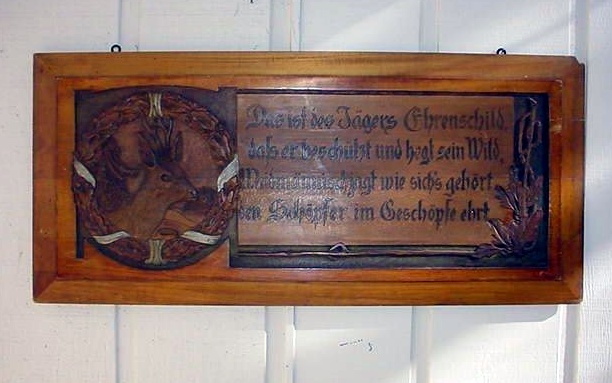
|

|
|
Magnificent (HUGE) Hunter’s Wooden Plaque (Hand Carved and Lettered) (Item ART 17-18; HUNT 8-8)
|
DESCRIPTION: For all of you collectors of hunting-related art or even collectors of fine, wood carvings, this is for you! It is a beautifully executed plaque that undoubtedly hung in the home of a Jäger (hunter) or perhaps in a hunting lodge in Germany. The depiction is of the German game animal known as the chamois and is an excellent example of Germanic wood carving at its best. The animal is surrounded by a wreath of oak leaves from the tree sacred to the Teutonic people. The three-dimensional emergence of this artistic achievement is incredible. The plaque is large measuring 43 x 20 inches.
The Inscription
Inscribed in indented carving are the words: “Das ist des Jägers Ehrenschild, das er beschützt und hegt sein Wild, Waidmännischjagt wie sichs gehört den Schöpfer im Geschöpfe ehrt .“
Roughly (quite roughly) translated for meaning: “The forester’s sign of honor is such that he protects and preserves the game and it is his position that he listens and obeys the high command that there is meaning, dignity, and importance to every creature and living being.” (Editor’s note) If the entire world could remember this equation then peace would truly rule the planet!
The plaque is generally in good shape with one chip out of the right-side top of the framing. All the artistic carving is perfect including the chamois and the oak-leaf configuration on the right side. This is a beautiful significant piece of art from what was a better age.
PRICE: SOLD
|
|
Exceedingly Important Tapestries of the Third Reich |

The Berchtesgaden Chancery tapestry; later in Himmler’s home
|
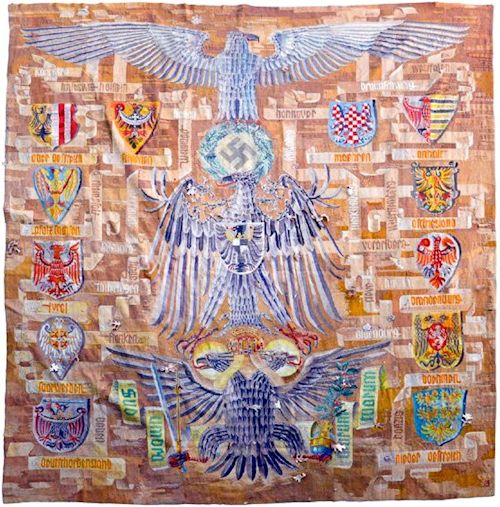
This is “Der Grosse Wandteppich” (The Great Tapestry), a genuine Munich Gobelin that was missing for many years and now discovered once again and is in a safe repository. This surely is the most meaningful tapestry to the Germanic mythus that was ever created in the Third Reich. It is huge--12 feet by 10 feet in size--and in its magnificent portrayals it shows the eagles of the three Reichs: the Holy Roman Empire is represented by the eagle at the bottom, and then the Hohenzollern Dynasty is represented, and after this at the top is the familiar and dominant eagle of the Third Reich.
|
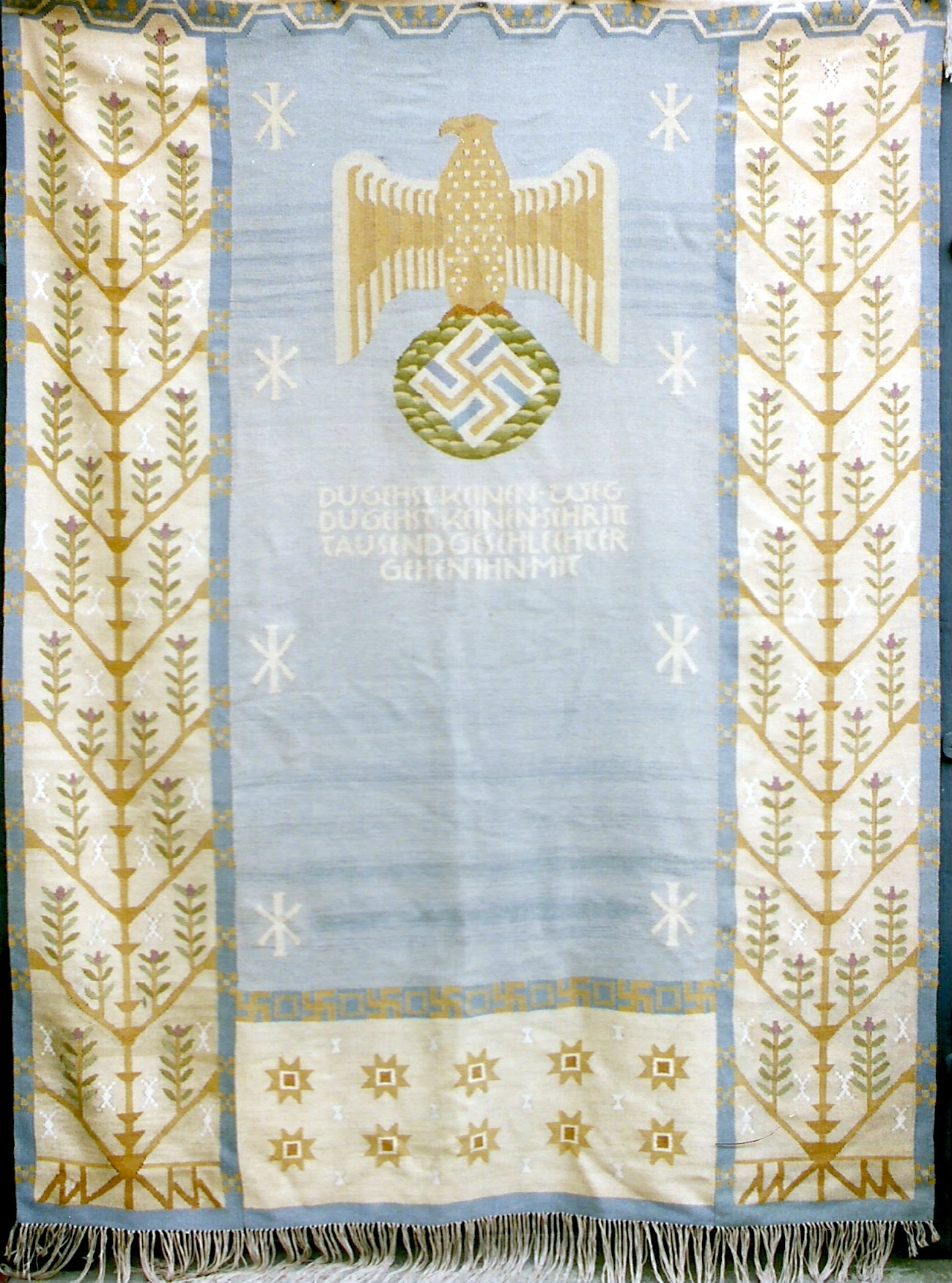
The Lebensborn tapestry: “When you walk on your way you cannot take one step when a thousand ancestors do not follow you."
|
| 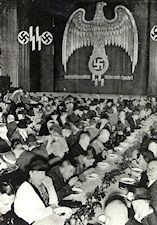
A giant Diebitsch tapestry as seen in the background of an  -sponsored Volksfest in Munich -sponsored Volksfest in Munich
|
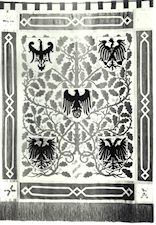
A tapestry by Professor Diebitsch depicting the history
of the symbol of the eagle of the German Reich
|
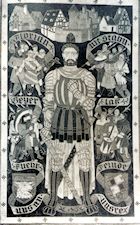
A Third Reich tapestry by Karl Heinz Dallinger; subject, the Knight Florian Geyer for the HQ of the 8th  Cavalry Division Cavalry Division
|
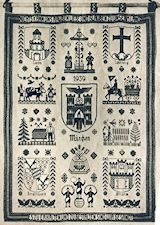
A Munich tapestry possibly made by Frau Hess, the wife of Rudolf Hess
|
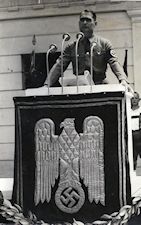
Deputy Führer Rudolf Hess with a silk-on-velvet tapestry
|
| 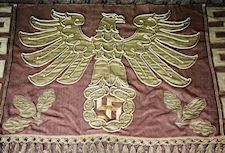
A tapestry from the parade that celebrated 2000 years
of Germanic culture and the opening of the House of German Art
|
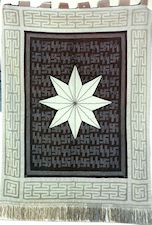
A Diebitsch tapestry made for the headquarters of  -Obergruppenführer and hereditary Prince Josias Waldeck Pyrmont in Arolsen. The star is the symbol of Arolsen. -Obergruppenführer and hereditary Prince Josias Waldeck Pyrmont in Arolsen. The star is the symbol of Arolsen.
|
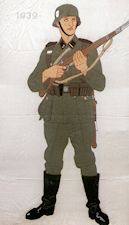
A tapestry by Elsie Seifert
|
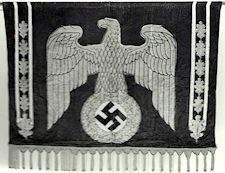
A Third Reich podium tapestry
|
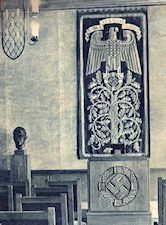
The Dallinger tapestry from the Nuremberg Gauleitung Ehrenhalle
|
| 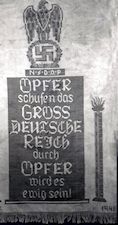
"Sacrifice created the Great German Reich, and sacrifice will make it eternal."
|

A theatre tapestry
|
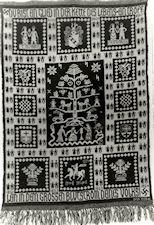
"You are but a link in the chain, a drop in the great bloodstream of your people!"
|
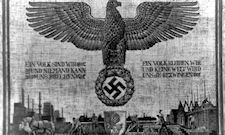
"We say from our mouths that no one can break our sprit.
We remain as a people and no world power will defeat us."
|
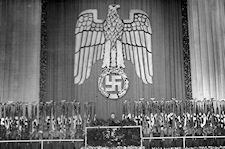
Gauleiter Burckel speaks to 15,000 political leaders
before an immense tapestry in Vienna.
|
| 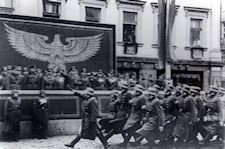
German police and  troops are reviewed by Heinrich Himmler who stands under a giant tapestry. troops are reviewed by Heinrich Himmler who stands under a giant tapestry.
|
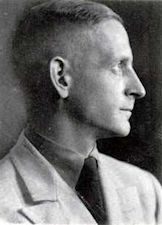
Professor and SS-Oberführer Karl Diebitsch;
possibly the designer of the tapestry
|
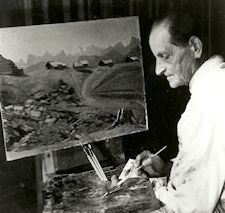
Professor Diebitsch in 1981--Ever the artist!
|
|
|
The Grand OKW “Oberkommando der Wehrmacht” Tapestry (Item ART 17-19: SS 38-2; TAPESTRY 1-3)
|
DESCRIPTION: We start this narrative with a statement that should go at the end, and that is: “What could be more important than this magnificent and prodigiously important relic of the Third Reich?” Here is the unique (and I use the term “unique” for its intended definition—“One of a Kind”) Wandteppich (tapestry) that once hung in the headquarters of the Supreme Command of the German Armed Forces. The OKW or Oberkommando der Wehrmacht was the organization that was responsible for all preparations for national defense in time of peace and for the conduct of operations in time of war. The head of the OKW was a cabinet member and represented the joint interest of the three branches: army, navy, and air force with respect to other departments of the government. The OKW was supreme and fully responsible for the coordination of the active war effort by the three subordinate branches, while the OK der Heeres (army) is responsible for all army matters, just as each of the other two high commands—air force and navy—were responsible for the application of general policies within each one's own sphere. In wartime, each high command had a forward echelon and a rear echelon. The forward echelon moves to a location appropriate to the theatre of main operations, while the rear echelon remains in the Berlin area; actually the building was Wündsdorf near Zossen in the outskirts of Berlin. Although it was not as grand as Göring’s air-ministry building on the Wilhelmstrasse it still was a classic example of Third Reich architecture. A branch of the OKW was on the Bendlerstrasse; now named the Stauffenbergstrasse after the traitor Claus von Stauffenberg who was a would-be assassin who planned with other army officers to murder the Führer. When the coup failed he was shot by firing squad on the spot. The fantastic tapestry was either from this HQ or the one in Wündsdorf-Zossen. Many of the very important Third Reich buildings had handmade tapestries within but the total amount couldn’t be over a dozen. We at Germania have owned and found homes for the tapestry’s from the  -Deutsches Ahnenerbe that was located in Berlin, and the Lebensborn tapestry that came from the Steinhöring home known as “Heim Hochland.” We have had several important smaller tapestries as well. The importance of tapestries to the National Socialist mythos cannot be underestimated. “The Norns” were in Norse mythology female beings who ruled the destiny of the gods and men as they spun the thread of fate at the foot of Yggdrasil (the world tree). They weave the threads onto a giant tapestry that predestines the lives of the human species. Recently a writer named Joan Schweighart wrote a story called “Gudrun’s Tapestry” based on Germanic legends. In the days when the church and great royal houses ruled the Germanic world tapestries were symbols of great wealth. Whenever official ceremonies or public celebrations were held, tapestries lent beauty and richness to the events. Bishops and kings welcomed important visitors with red carpets flanked by tapestry displays. Royal processions proceeded along routes flanked and marked with tapestries. So, with tradition being so prodigiously important to the N.S. artistic sense and because of the intellectual state of mind that prevailed, the display of tapestries became extremely aesthetically important to Hitler’s Reich. In the mid 1980s I had occasion to visit with former -Deutsches Ahnenerbe that was located in Berlin, and the Lebensborn tapestry that came from the Steinhöring home known as “Heim Hochland.” We have had several important smaller tapestries as well. The importance of tapestries to the National Socialist mythos cannot be underestimated. “The Norns” were in Norse mythology female beings who ruled the destiny of the gods and men as they spun the thread of fate at the foot of Yggdrasil (the world tree). They weave the threads onto a giant tapestry that predestines the lives of the human species. Recently a writer named Joan Schweighart wrote a story called “Gudrun’s Tapestry” based on Germanic legends. In the days when the church and great royal houses ruled the Germanic world tapestries were symbols of great wealth. Whenever official ceremonies or public celebrations were held, tapestries lent beauty and richness to the events. Bishops and kings welcomed important visitors with red carpets flanked by tapestry displays. Royal processions proceeded along routes flanked and marked with tapestries. So, with tradition being so prodigiously important to the N.S. artistic sense and because of the intellectual state of mind that prevailed, the display of tapestries became extremely aesthetically important to Hitler’s Reich. In the mid 1980s I had occasion to visit with former  -Oberführer and Professor Karl Diebitsch who was the artist responsible for the beginnings of the porcelain art industry known as Allach. He was also the designer of much of the SS regalia including the chained Mod 36 SS dagger. Go to our -Oberführer and Professor Karl Diebitsch who was the artist responsible for the beginnings of the porcelain art industry known as Allach. He was also the designer of much of the SS regalia including the chained Mod 36 SS dagger. Go to our  -Schutzstaffel page and at SS 36-14 find more information on Prof. Diebitsch and the dagger. It was Diebitsch who designed the black SS uniform. He also designed a whole series of tapestries for the SS and other N.S. groups. This fabulous tapestry may well be one designed by this brilliant artist. Another tapestry we have offered is the one known as the Himmler wall hanging. Go to SS 36-15 to see that one, which is the most colorful one we have ever encountered. You will find more information about tapestries there. I mentioned in that article that there was no more a valued article to the Third Reich doctrines than these great wall hangings. Professor Diebitsch designed them and they were constructed by his sister, Elsie Seifert, both in completely woven design or applique, or both. Diebitsch tapestries stood alone in the use of almost iridescent silk cloth used to highlight certain areas of the work with bright gold or silver hues such as you can see between the eagle’s limbs and behind the swastika on this OKW wall hanging. In the Himmler tapestry the gold is very evident and the highlights are the swastikas and oak-leaf branches. -Schutzstaffel page and at SS 36-14 find more information on Prof. Diebitsch and the dagger. It was Diebitsch who designed the black SS uniform. He also designed a whole series of tapestries for the SS and other N.S. groups. This fabulous tapestry may well be one designed by this brilliant artist. Another tapestry we have offered is the one known as the Himmler wall hanging. Go to SS 36-15 to see that one, which is the most colorful one we have ever encountered. You will find more information about tapestries there. I mentioned in that article that there was no more a valued article to the Third Reich doctrines than these great wall hangings. Professor Diebitsch designed them and they were constructed by his sister, Elsie Seifert, both in completely woven design or applique, or both. Diebitsch tapestries stood alone in the use of almost iridescent silk cloth used to highlight certain areas of the work with bright gold or silver hues such as you can see between the eagle’s limbs and behind the swastika on this OKW wall hanging. In the Himmler tapestry the gold is very evident and the highlights are the swastikas and oak-leaf branches.
The OKW Tapestry
This beautiful tapestry bears the stylized Wehrmacht eagle separately sewn on. The eagle looks to its left and clutches an oak-leaf wreath with four Teutonic swords crossing each other behind the wreath. The eagle’s limbs and talons are accented, as is the swastika with gold-bullion cloth that gives it a rather three-dimensional effect. The uppermost portion displays a curved bandeau while the underside has a decorative oak-leaf braid and numerous applied rosettes. Both sides have pressure marks from a frame that had contained it (when?) The wall hanging lay for decades in a small Russian museum outside Moscow and recently it was bought by our German picker and thus returned to Germany and is now in the U.S. This may be the most important tapestry of Third Reich origin ever offered. It is a big 16 x 8 feet (192 x 96 inches or 490 x 245 cm). Let it be said that only Germania International could bring such fabulous articles forth to the collecting public.
PRICE: For now it will be priced upon request. Serious inquiries only.
|
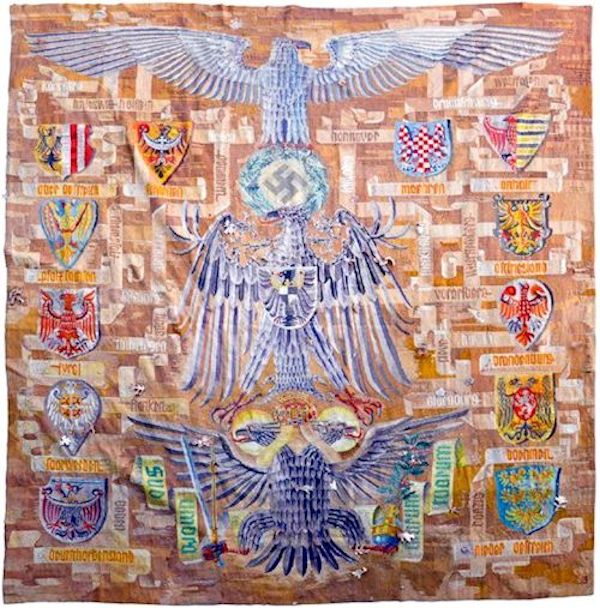
|
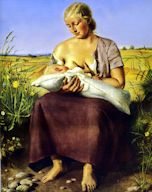
Karl Diebitsch's masterpiece titled “Mutter”
|
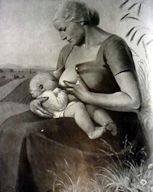
A later version of “Mutter” by Diebitsch
|

Karl Diebitsch in his Allach studio
|
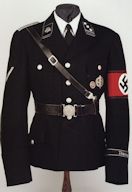
The Allgemeine-SS uniform designed by Prof. Diebitsch
|

Vase presented to Hitler that was designed by Prof. Diebitsch
|
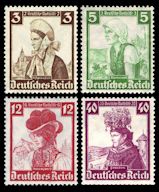
Some of the postage stamps designed by Prof. Diebitsch
|
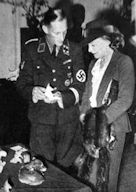
Prof. Diebitsch demonstrates Allach products to actress Hilde Hildebrand
|
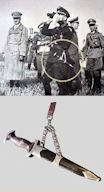
The chained model SS dagger designed by Prof. Diebitsch
|
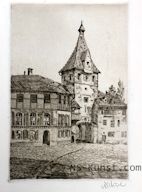
A rendering by Karl Diebitsch
|
|
“Der grosse Wandtappich” "The Great Tapestry" (Item ART 17-19a, SS-37-12)
|
DESCRIPTION: When our advisor R. Johnston visited and interviewed Professor and former  Oberführer Karl Diebitsch in Tegernsee, he intently listened as the professor spun the tales of the Allach porcelain legend that was so beloved to him. Diebitsch and his sister, Frau Elsie Seifert, told Johnston about the very beautiful and profoundly meaningful tapestries that Karl designed and she wove and constructed. These tapestries invariably told fascinating stories and they probed the mythos of the Teutonic past and proclaimed the glories of the National Socialist Third Reich. After the disastrous end of the Second World War, practically all of these wonderful art pieces disappeared into what seemed to be consummate oblivion. Professor Diebitsch seemed to feel that the tapestries were even more important to the National Socialist mythos than even the Allach porcelain and the Allach firm which he was, by the way, the founder of. At the time, Mr. Johnston was attempting to write a book on Allach porcelain and even more importantly he was gathering research on the tapestry of the Ahnenerbe Stiftung that hung in the offices of this wonderful heritage foundation based in Berlin. Professor Karl Diebitsch (January 1899–August 1985) was an artist personified, and he was the designer responsible for most of the regalia used by the Oberführer Karl Diebitsch in Tegernsee, he intently listened as the professor spun the tales of the Allach porcelain legend that was so beloved to him. Diebitsch and his sister, Frau Elsie Seifert, told Johnston about the very beautiful and profoundly meaningful tapestries that Karl designed and she wove and constructed. These tapestries invariably told fascinating stories and they probed the mythos of the Teutonic past and proclaimed the glories of the National Socialist Third Reich. After the disastrous end of the Second World War, practically all of these wonderful art pieces disappeared into what seemed to be consummate oblivion. Professor Diebitsch seemed to feel that the tapestries were even more important to the National Socialist mythos than even the Allach porcelain and the Allach firm which he was, by the way, the founder of. At the time, Mr. Johnston was attempting to write a book on Allach porcelain and even more importantly he was gathering research on the tapestry of the Ahnenerbe Stiftung that hung in the offices of this wonderful heritage foundation based in Berlin. Professor Karl Diebitsch (January 1899–August 1985) was an artist personified, and he was the designer responsible for most of the regalia used by the  to include the officer’s model chained to include the officer’s model chained  dagger and the well-known black dagger and the well-known black  uniform and also the uniform and also the  and police (Degen) ‘sword.’ It was he that did the original (entwurf) “designs” for all the most important tapestries that had and police (Degen) ‘sword.’ It was he that did the original (entwurf) “designs” for all the most important tapestries that had  themes. He received one of the top art prizes at the House of German Art for his remarkable oil painting titled “Mutter” (“Mother”). He also designed many of the Reich’s postage stamps. When Mr. Johnston visited Prof. Diebitsch the learned man did at one point describe how he came to be the designer of these wonderful tapestries and told Mr. Johnston that it was his sister, Elsie Seifert, that actually wove these wonderful Wandteppiche (tapestries) along with an assistant by the name of Fraulein Stronika. Their firm in Munich, if we remember right, was called München-Gobelin. When listening to Dr. Diebitsch as he described his many tapestries, there came a time when Frau Seifert gave Mr. Johnston quite a few original pictures of tapestries that she had created from the designs of her illustrious and highly talented brother. One thing that utterly fascinated Mr. Johnston was a certain artwork that both the professor and his sister described as ‘Der grosse Wandteppich”–“The Great Tapestry.” This, it would seem, was the most important and most beautiful one that they had ever produced. It was thought to be hung outside or inside the main entrance to Adolf Hitler’s office in the Reich’s Chancellery in Berlin. It may, however, have hung in the House of German Art in Munich before going to its final destination and it’s also possible that it never got to the Reich’s Chancellery and we can, I suppose, be grateful that it did not, since the chancellery was entirely gutted and all contents burned by the vicious barbarian hordes that steamrolled over all of Berlin. Diebitsch and his sister were deservedly proud of all their tapestries, but this one was not only their pride and joy, but they thought it to be the most important one produced as it depicted German glory through the ages. Unfortunately, however, they did not have a single picture of it. Evidently there were numerous pictures of it in a special album that Frau Seifert
put together back in the era, but the album was stored at the offices of München-Gobelin Wandteppichwerk and the building was completely burned when allied bombs hit the display and storage units and destroyed many other precious artworks as well as this precious album. Mr. Johnston does remember that they told him this tapestry splendidly imparted the romance and history of the First, Second, and Third Reichs with symbols depicting all these empires and it had heraldic shields that included the Wappen or crests of several of the most important districts of the united Reich and the Holy Roman Empire. This remained stuck in Johnston’s mind over the years since his meeting with the professor and he often thought he would absolutely love to see a picture of this fabulous work of the weaver’s art. However, he figured and was sure he never would. Then! In May 2014, he saw to his absolute amazement suddenly that there was a giant tapestry that was featured in the auction offerings of Mohawk Arms in New York. The tapestry was being called the “N.S. Reichstag National Culture-Gobelin Tapestry.” The minimum bid was shown to be $25,000 and amazing that it did not bring it, but it definitely takes a person steeped in history and culture to appreciate a masterwork such as this. Unfortunately, I did not see it until after the auction was concluded and I couldn’t have handled it at that time in any case, even though my advisor, R. Johnston thought it to be definitely the most important purchase that could ever be accomplished and he was positive that here was the actual Grosse Wandteppich but he did not see it, either, until the auction was over. He was and is sure that it is most assuredly the very same “great tapestry” as described by Professor Diebitsch and Frau Seifert. Later, it came up again in another auction, but still it was with a very substantial starting bid. This was included in the “History Hunter Auction” where it was featured with a minimum bid of $25,000, but again we did not buy it. Why? Frankly, we knew it was worth a great deal more but the item came up again just when we had a crisis in hand. Then, miraculously, we finally had a last chance to buy it from the original owner at a time when we were able to do so with the welcome help of a well-known dealer in the field. This was one of the greatest highlights of any career in this particular line. The dealer knew that of all the collectors and dealers in this field that Germania International would be almost singular in a true appreciation and knowledge of such an important cultural item like this. In addition, of course, I personally can attribute this to the knowledge of R. Johnston, an astute historian of long standing. This piece is more culturally important than any of the wonderful tapestries dedicated to the astounding Third Reich mythos, and this one, Der grosse Wandteppich, is surely the most important of all! themes. He received one of the top art prizes at the House of German Art for his remarkable oil painting titled “Mutter” (“Mother”). He also designed many of the Reich’s postage stamps. When Mr. Johnston visited Prof. Diebitsch the learned man did at one point describe how he came to be the designer of these wonderful tapestries and told Mr. Johnston that it was his sister, Elsie Seifert, that actually wove these wonderful Wandteppiche (tapestries) along with an assistant by the name of Fraulein Stronika. Their firm in Munich, if we remember right, was called München-Gobelin. When listening to Dr. Diebitsch as he described his many tapestries, there came a time when Frau Seifert gave Mr. Johnston quite a few original pictures of tapestries that she had created from the designs of her illustrious and highly talented brother. One thing that utterly fascinated Mr. Johnston was a certain artwork that both the professor and his sister described as ‘Der grosse Wandteppich”–“The Great Tapestry.” This, it would seem, was the most important and most beautiful one that they had ever produced. It was thought to be hung outside or inside the main entrance to Adolf Hitler’s office in the Reich’s Chancellery in Berlin. It may, however, have hung in the House of German Art in Munich before going to its final destination and it’s also possible that it never got to the Reich’s Chancellery and we can, I suppose, be grateful that it did not, since the chancellery was entirely gutted and all contents burned by the vicious barbarian hordes that steamrolled over all of Berlin. Diebitsch and his sister were deservedly proud of all their tapestries, but this one was not only their pride and joy, but they thought it to be the most important one produced as it depicted German glory through the ages. Unfortunately, however, they did not have a single picture of it. Evidently there were numerous pictures of it in a special album that Frau Seifert
put together back in the era, but the album was stored at the offices of München-Gobelin Wandteppichwerk and the building was completely burned when allied bombs hit the display and storage units and destroyed many other precious artworks as well as this precious album. Mr. Johnston does remember that they told him this tapestry splendidly imparted the romance and history of the First, Second, and Third Reichs with symbols depicting all these empires and it had heraldic shields that included the Wappen or crests of several of the most important districts of the united Reich and the Holy Roman Empire. This remained stuck in Johnston’s mind over the years since his meeting with the professor and he often thought he would absolutely love to see a picture of this fabulous work of the weaver’s art. However, he figured and was sure he never would. Then! In May 2014, he saw to his absolute amazement suddenly that there was a giant tapestry that was featured in the auction offerings of Mohawk Arms in New York. The tapestry was being called the “N.S. Reichstag National Culture-Gobelin Tapestry.” The minimum bid was shown to be $25,000 and amazing that it did not bring it, but it definitely takes a person steeped in history and culture to appreciate a masterwork such as this. Unfortunately, I did not see it until after the auction was concluded and I couldn’t have handled it at that time in any case, even though my advisor, R. Johnston thought it to be definitely the most important purchase that could ever be accomplished and he was positive that here was the actual Grosse Wandteppich but he did not see it, either, until the auction was over. He was and is sure that it is most assuredly the very same “great tapestry” as described by Professor Diebitsch and Frau Seifert. Later, it came up again in another auction, but still it was with a very substantial starting bid. This was included in the “History Hunter Auction” where it was featured with a minimum bid of $25,000, but again we did not buy it. Why? Frankly, we knew it was worth a great deal more but the item came up again just when we had a crisis in hand. Then, miraculously, we finally had a last chance to buy it from the original owner at a time when we were able to do so with the welcome help of a well-known dealer in the field. This was one of the greatest highlights of any career in this particular line. The dealer knew that of all the collectors and dealers in this field that Germania International would be almost singular in a true appreciation and knowledge of such an important cultural item like this. In addition, of course, I personally can attribute this to the knowledge of R. Johnston, an astute historian of long standing. This piece is more culturally important than any of the wonderful tapestries dedicated to the astounding Third Reich mythos, and this one, Der grosse Wandteppich, is surely the most important of all!
The Tapestry
The tapestry as far back as we can locate its history was sold by famed militaria dealer Tony Oliver in England to the well-known U.S. collector Jerry Davis about 45 years ago and during the time Oliver owned it he very unfortunately rented it out to the MGM film studio to be used in probably the movie that was even worse than the filth and genocidal murder depicted in the film Inglourious Basterds or even Rage. Brad Pitt and Lee Marvin should be drawn and quartered along with the rest of the miscreants like Quentin Tarantino who produces such garbage. Luckily, the tapestry only revealed the very bottom of itself and only for a few seconds and its brilliant integrity was not soiled by its misuse in the rotten film The Dirty Dozen. The tapestry was sold by Oliver to Mr. Davis for $10,000.00 in 1968. It shows the three Germanic Reichs while employing the symbolic eagles of each of these empires. We know that the Third Reich was a continuum of the Carolingian Empire and that of course is the double-headed eagle depicted at the base of the work and then above this is the eagle of the Second Reich with the eagle of the Hohenzollern Prussian Monarchy in the middle of its chest. Then above and of course dominant, is the eagle and swastika of the Third Reich. All through the tapestry are enjoyning bands with the names of the various historical districts that made up these proud and noble Reichs, and along with this can be seen the shields of these districts all in full vibrant color. This is an entirely handwoven Gobelin (not applique). Germania International has long been specializing in important Third Reich tapestries. Please read more about such works at the item above. There you will see the OKW tapestry that we thought was the most important tapestry of Third Reich origin ever offered and it certainly is and was until miraculously we found this one. No tapestry could exceed this one!! Among the twelve embroidered shields there are included the Wappen arms of Über Oestreich, Schlesian, Anhalt, Pfalz, Sachen, Ostfriesland, Tyrol, Brandenburg, Franken, Boehmen, Deutschordensland, and Nieder Oestreich. Other areas are named on the series of connecting legends. All three eagles are embroidered in shades of silver/gray/black and are more pronounced with the addition of other colors emphasizing crown, sword, orb, and oak leaves. The background consists of subdued shades of brown/tan/dull gold-brown. The absolute utter magnitude of this monumental tribute to the glory of what was once Germany (pre-Merkel) is astounding and if it survives and someday if sanity prevails it will be considered a true treasure of the Western experience–“Deutschland, Deutschland über alles, über alles in der Welt.”
PRICE: For now it will be priced upon request. Serious inquiries only.
|
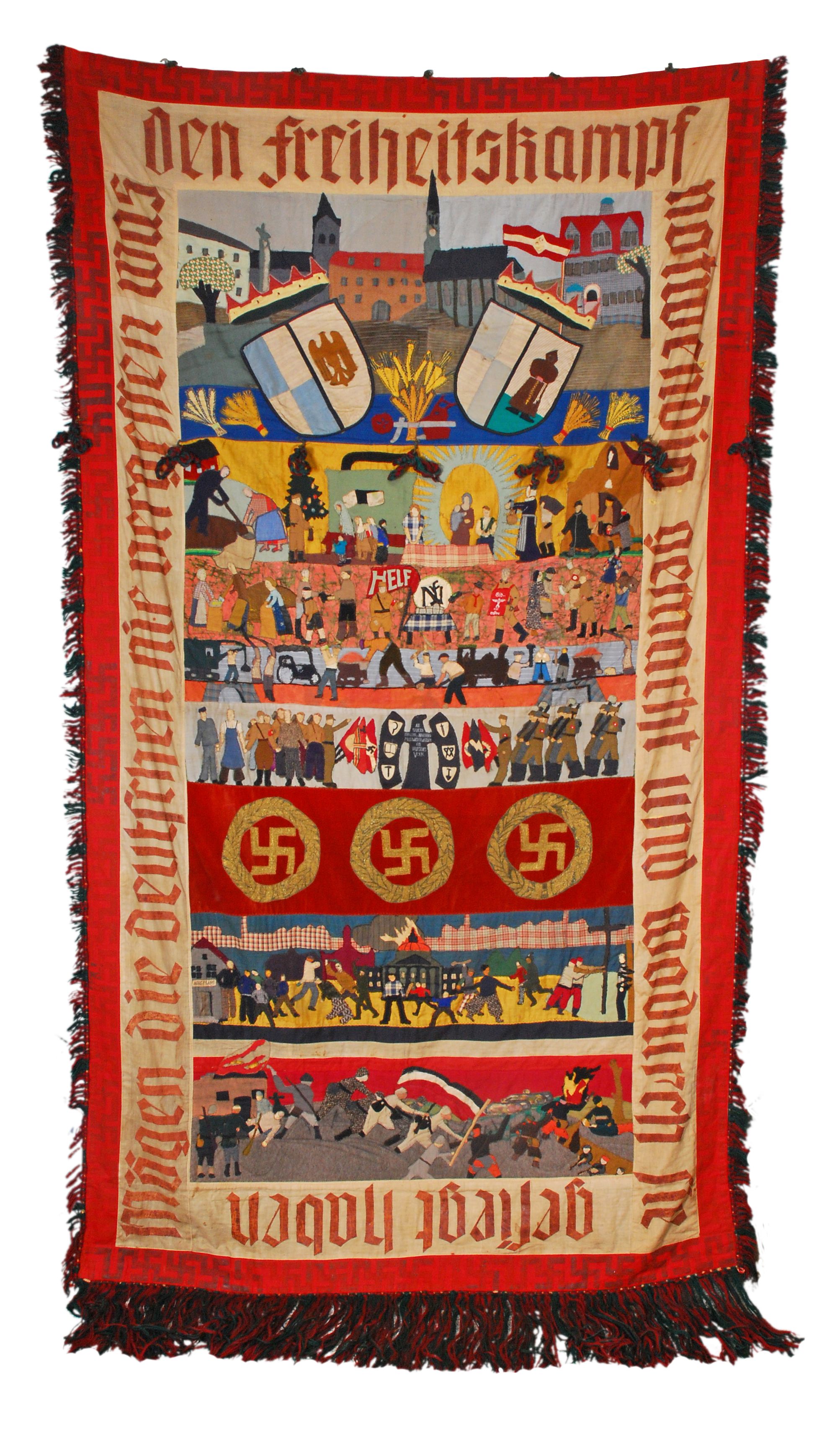
|
The incredible tapestry demonstrating in caricature the saga of the Third Reich |
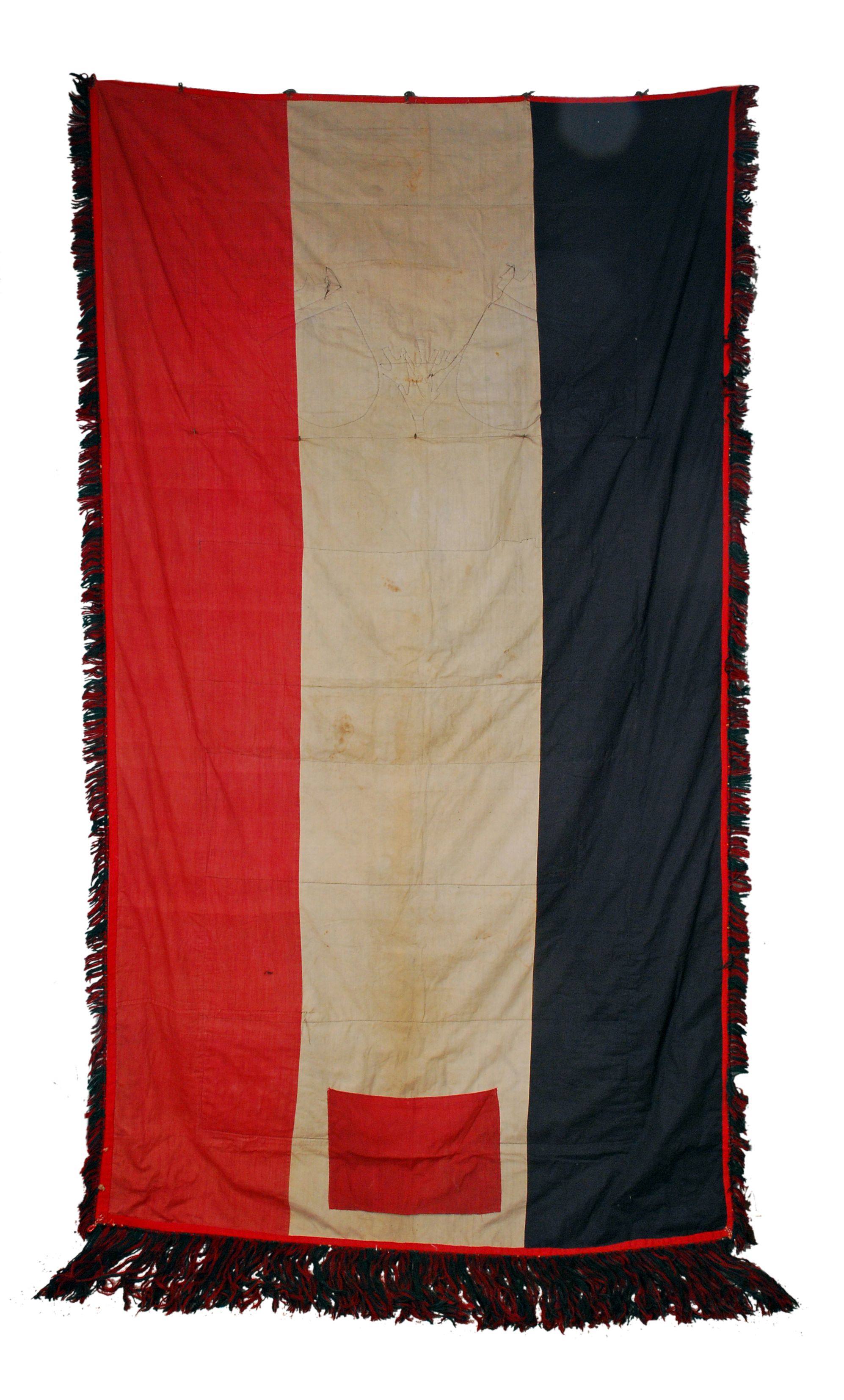
Backside of the tapestry showing the German national
colors used during the Third Reich
|
|
Fantastic National Socialist Tapestry that tells the Story of the Third Reich (Item ART 17-9b; TAPESTRY 1-1)
|
| DESCRIPTION: Here is one of the absolutely, most-fantastic art treasures of the Third Reich as depicted through the art of weaving. It traces the story of the National Socialist Movement and the catastrophic events that engendered it. The sequence follows a historical pattern and is a potpourri of various vignettes that pictorially illustrate some of many of the eventful scenarios that occurred before and after Hitler’s “Machtergreifung” (ascension to power).
The tapestry is presented in colorful panel art in full, vibrant colors woven by hand onto a woolen background material. All around the four edges are swastikas in sort of a Greek key pattern that was so prevalent in N.S.-period artwork. The words in German that are seen on the cream-colored inner section are as follows: “den Freiheitskampf” (“Struggle for Freedom”). Then around the edges are the words that translate: “May the German people never forget what made the war of liberation necessary and yet they have triumphed.” The first and top panel shows the crests of Munich with a scene of various buildings and the Feldherrenhalle where the famous Beer Hall Putsch marchers met a tragic end: it was here that the N.S. mythos was created in 1923. In the next panel, there are depictions of the German people and their everyday activities as a God-fearing, orderly people with ethics and morals aforethought, and having an intense and unshakable love for their Fatherland. This panel also represents the Volksgemeinschaft (people’s community) which united the different classes of workers and led to the restoration of Germanic family values and the return of employment, industry, and prosperity. In the third panel, these stout-hearted Teutonic folk are seen enjoying the social benefits offered when National Socialism was offered as a promised national relief after the horrors of WWI that was thrust upon Germany and its people; for instance, the horrid, vengeful Treaty of Versailles that punished them so unfairly and so very grievously. In the fourth panel, we see the people as they struggle through honest and dedicated labor to bring their nation back to its former glorious identity as the industrious power that it once was before Britain’s greed conspired to bring down the German nation. The fifth panel shows the various uniformed social organizations that were formed to benefit the nation’s resolve. These were the women’s Frauenschaft, the Reich’s Labor Service, the Hitler Youth, the SS, and the SA. Below this, we see a grouping of three golden swastikas encased in golden wreaths of oak leaves. This divides the positive aspects that are seen above that represent the awakening and arising of the German people brought about under National Socialism. Then, underneath this the dark panel illustrates the degradation and sheer horror bestowed on the Deutschen Volk and what they had to endure in the postwar era during the time of the Weimar Republic. This era saw the burning of the Reichstag (Parliament Building) by the Reds, the terrible time of chronic unemployment, the terrible Communist Insurrection, and the reprehensible persecution of the National Socialists by the police under the vicious police commissioner, Bernhard Weiss, in Berlin. This panel also depicts the martyrdom of nationalistic patriots such as the execution of the people’s hero, Albert Leo Schlageter, by the French in the occupied Rhineland. The last panel depicts the Germans who were finally awakened and united under National Socialism putting down the Spartacus revolutionaries, the Communists, and the hated French Army occupiers, and it shows the Freikorps (Free Corps) in action against all of these enemies of the Volk. So, in essence, the history of the movement and the temporary triumph of the Germanic people are graphically depicted in cloth. The tapestry is BIG! and not including the fringe it is 8 feet tall and 4 feet wide. This measurement does not include the seven round loops at the top of the tapestry that facilitate the hanging of it on a wall. They measure about ½ inch each. The tapestry weighs 15 or 20 pounds and was designed no doubt for display in a meeting hall probably in Munich, the Hauptstadt der Bewegung (capital of the movement), or possibly it hung in the Ratthaus (city hall). It just has that feeling! In any case, it is ranked among the best-looking tapestries we have ever seen in any collection. The deep and significant meanings are all encompassed into one masterpiece of the weaver’s art. In ancient Teutonic legend, there were three mysterious women called “Norns” and they weaved a special tapestry that controlled the metaphorical thread of life of every mortal from birth to death. We actually see a parallel here. The Norns were said to weave their tapestry that controlled man’s history and destiny. We can see something similar here in the fact that one, or perhaps all three women, weaved this Wandteppich (tapestry) that traced the history of the movement that really decided the destiny of Germany and, for that matter, the world. The tapestry of the Norns was weaved at the foot of Yggdrasil (World Tree), while this tapestry we present here was most probably woven by modern-day Norns in the National Socialist Women’s League called the NS-Frauenschaft. Its logo is in the center of the work. This, to my perception, is a sort of signature to the work since no other organizational symbol is used except for the banner of the Hitler Youth in the top panel, but that is shown waving from a school signifying the new N.S. education standards to the German people. We are tapestry people! This is possibly one of the prettiest tapestries we have ever seen as well as being so prodigiously historically important. We honestly believe that these Wandteppiche were the almost-sacred relics that when found can be seen to represent the great imperatives and the evidences of a culture that was both momentous and profoundly consequential to world history. This Kultur above all was the “Imperium” of the western world and its culture-bearing stratum is—alas—“gone with the wind!” and certainly with serious untoward negative consequences for the future. Hitler once said when officiating at the opening of the Haus der Deutschen Kunst in Munich: “Kein Volk lebt länger als die Dokumente seiner Kultur.“ Here is a grand unique special document of the National Socialist culture and saga in an art form that was sacrosanct to the N.S. culture almost exclusively in the 20th century. There never was another, and in this age of mostly degenerate art, it is likely that there never will be another.
PRICE: |

|

|
Skizzen aus dem Ostfeldzug (Sketchs from the Eastern Front) (Item ART 17-20; WEHR 33-8) |
| DESCRIPTION: Here is a nice little hardcover military-art book that chronicles the German army’s fighting the Reds in the East (Russia). It has about 60 pages of real art from memories by frontline artists depicting these German soldiers as they valiantly fought against the “forces of Hell.” This was truly the greatest and bloodiest struggle the world has ever seen and, as we know, they lost because of Western support for the communists coming from the nations closest related to their race, nationality, and religion all for the sake of Stalin’s Red hordes. The book measures 5 ½ x 7 ½ inches. The spine and binding are a bit tattered, but the pictures and pages are in great shape. The images—some in color; some in black and white—are simply wonderful. Great is the fantastic portrayal of this horrendous war to save Europe from the clutches of the “devil incarnate” (Stalin). Some of the pictures depict Russian prisoners. Compare their dismal looks with the noble Aryan faces of the German soldiers and it’s quite a contrast, to say the least. This is a great little book, a treasure of memory of the Deutscher Freiheitskampf in the East.
PRICE: $125.00 |

|
New Arndt Publication Das Haus der Deutschen Kunst 1937-1944; Band III: Kriegsmaler (Item ART 17-21; ENGBOOKS 1-5) |
| DESCRIPTION: Here is the volume all have been waiting for and all in full color. This is the Kriegsmaler (war painter) edition portraying the art of the Second World War and World War One depictions, as well. It is chock full of wonderful depictions in the heroic National Socialist art form of Germany’s soldiers, sailors, airmen, and Waffen-SS as they fight for Europe’s freedom on several fronts. The portraits are stunning in their stark realism, beautiful and definitely not puny Picasso trash. Here is valor, dedication, honor, and loyalty as envisioned by the greatest artists the world has ever known; men who fought with brush in hand keeping alive a flame without compromise as if almost by divine intervention. The special art inspired by National Socialist principles and agenda will never be equaled and its detractors are what we consider “Belanglosen.” This is a proper German word that translates to “inconsequentials.” Modern degenerate art will not be found in these pages. Unfortunately, much of this trash can be found in the “Haus der Kunst,” today. Notice: that the name “Deutschen” is now dropped. “Heavens! It would not do to have something with the name 'German' in the country of Germany, would it”? So, dear reader, until the west wakes up (if ever) we must be content to brighten our days with books such as this. The color couldn’t be more true to life (“brilliant”). We all have the Arndt publishers to be grateful to for producing such fantastic volumes bringing forth the scope and reality of that era of heroism known as “Das Dritte Reich.”
PRICE: $78.00 + postage |
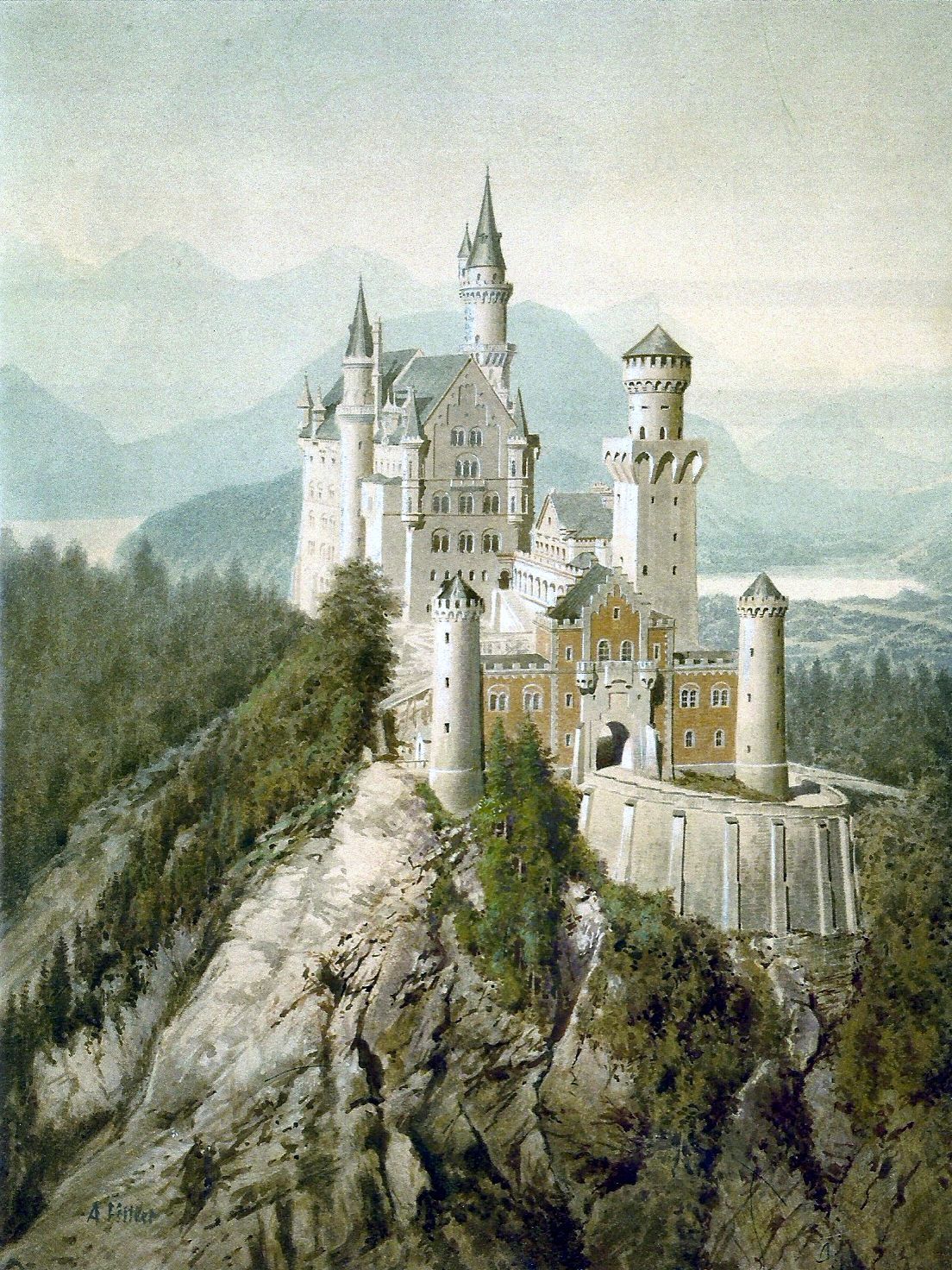
Actual watercolor by Adolf Hitler |
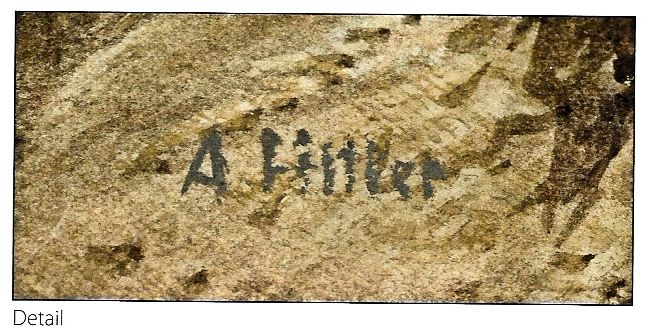
Adolf Hitler's signature as seen on the painting |
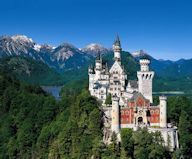
Castle in a recent photograph
|
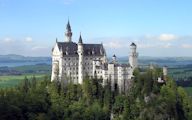
Side view of castle as it stands, today
|
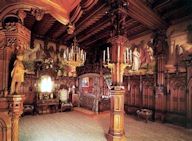
Interior room
|
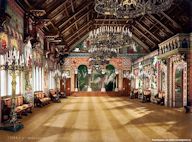
More of castle's interior
|
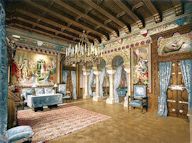
Another interior view
|
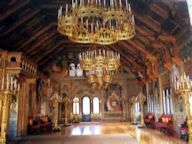
The throne wall
|

The vestibule
|
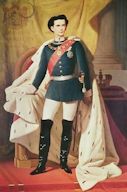
Ludwig II, the Bavarian king who created Schloss Neuschwanstein
|
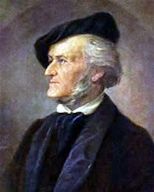
Richard Wagner, the man Schloss Neuschwanstein was dedicated to
|
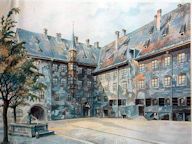
Another example of Hitler's artwork
|

Another example of Hitler's artwork
|
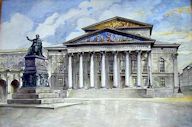
Another example of Hitler's artwork
|
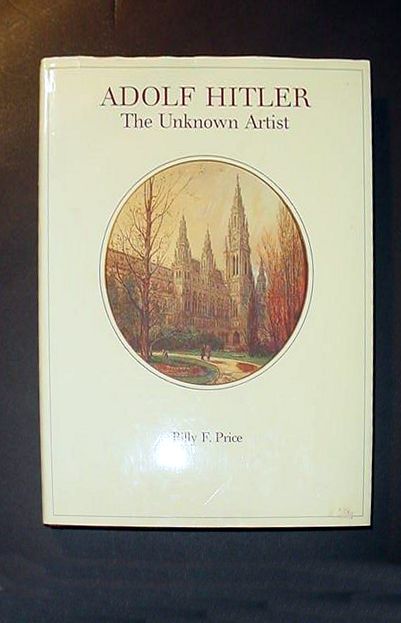
This is the
book by Billy Price on the paintings of Adolf Hitler. It is the only complete
book so far published on the subject, and both of the paintings we offer are
listed and pictured (the very ones!). |
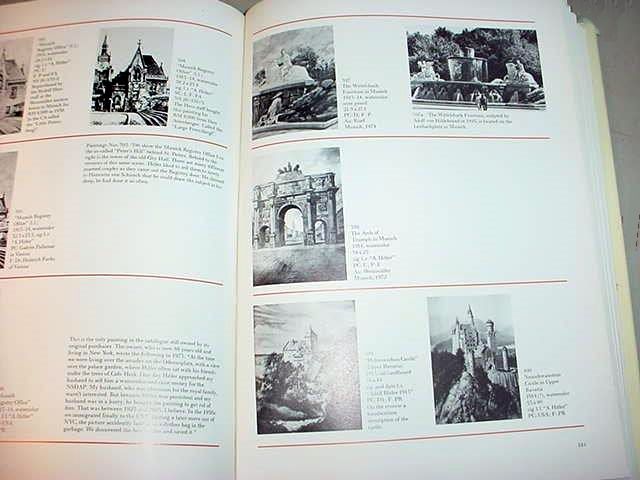
Here is the watercolor of the castle in black and white as shown in the book. |
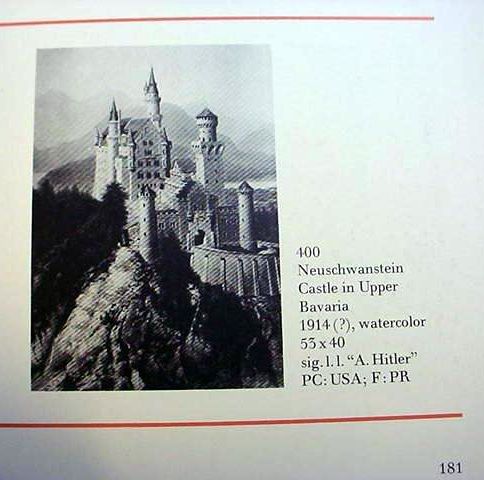
The castle on page 181 of Billy Price's book. |

Hitler’s signature changed over the years. Authentic watercolors by him have been seen with several of his varied signatures (No two were ever alike.). Please understand that not all the signatures pictured in this image are from paintings, but they are from Billy Price's book Adolf Hitler: The Unknown Artist. Those signatures in rows 4 and 5 are actually from Hitler's various watercolors. Note that the third one in row 5 is nearly identical to the one on the castle painting as seen above. |
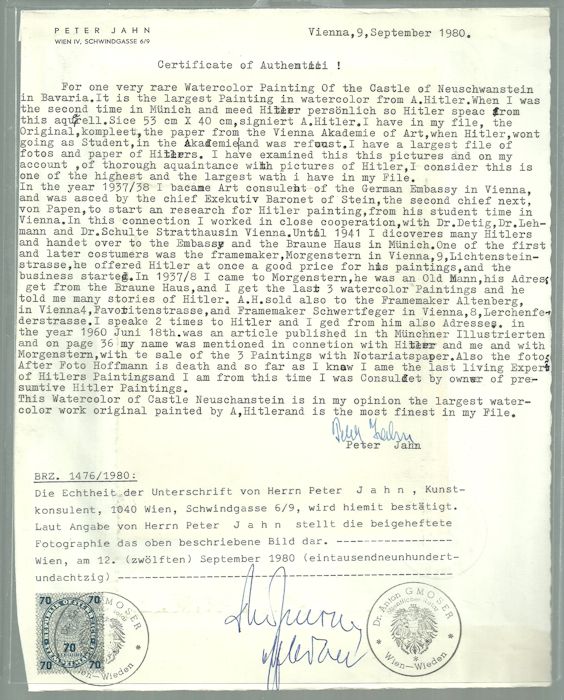
| 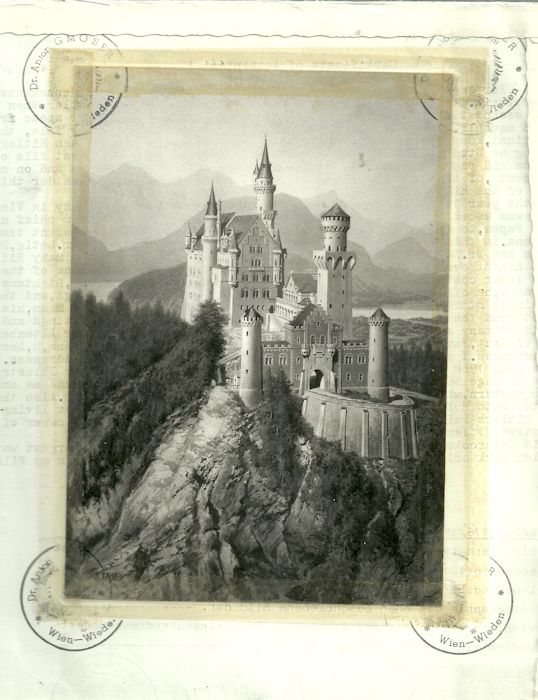
Here is the picture of the painting with notary seals secured to the back of the official statement (on the left) by Peter Jahn
|
|
Watercolor by Adolf Hitler With Strong, Official Provenance and Expertise (Item ART 17-22; AH 28-13; SPECIAL ITEM)
|
DESCRIPTION: Recently, we were very fortunate to purchase two paintings by Adolf Hitler that are actually considered among his best. This first one shown here is an absolutely gorgeous rendering of the Castle of King Ludwig II of Bavaria—Schloss Neuschwanstein (New Swanstone Castle). This is a nineteenth-century Romanesque Revival palace. It was built by King Ludwig II as a devout homage to the great composer Richard Wagner, whom he practically worshipped. Therefore, it only follows that Adolf Hitler, who was also a devoted fan of the great Wagner would seek to honor him. It seems only logical, therefore, that New Swanstone Castle would be a natural for the young Hitler to paint at some time in his artistic career and, in my estimation, his infatuation with Wagner would have enthused him to positively strain to make this fantastic watercolor one of his finest works. The majesty of the castle as seen in Hitler’s painting is spellbinding and all who have seen it have praised it not only because it is Hitler’s work, but the painting itself emerges as a classic example of fine art of the Western world. Yes, it’s that great! Crude propagandist authors have said that Hitler was only a “house painter” before he became Germany’s leader. I am sure you have heard or seen that ignorant old canard more than once. Well, dear reader, this is one of the “houses” he painted. So just like all the other lies told about the German Führer this one needs to be trashed as well, wouldn’t you agree? We at Germania are proud as peacocks to offer this (dare I say: “masterpiece?”). “Yes, I dare!” Of all the watercolors painted by Hitler, this is one of the largest we have seen. The only full and significant literary work dealing with Hitler’s paintings is titled Adolf Hitler: The Unknown Artist by Billy F. Price, and this painting is shown on page 181 of the book and is listed as plate number 6/100. Where it is shown it says it was painted in 1914 and I think it may have been among the last renderings he produced before enlisting in the Bavarian Army and going off to war. He still found some time to paint a few Munich scenes during that period. Painting was his favorite thing in life and with high hopes, he took the examination to attend art school. To his complete disappointment, he and 85 other candidates failed the exam and were denied entrance to the prestigious Vienna Academy of Fine Arts. Today, we know that the test was stacked against the candidates; the required subjects of the exam were rather strange and the judges may have been rather prejudiced toward certain applicants from “select families.” We will never know, but when one views either of the paintings that we at Germania have procured and offer, there is not a shadow of a doubt that the young Adolf possessed a genius in architectural mastery in the arts. Just as he had opinions in the political arena and in the winning strategy in warfare (Blitzkrieg) his opinions and thoughts about art were strong and rather far beyond conservative. He believed strongly that “healthy art” had a “healthy soul.” He claimed it should be uplifting, noble, and idealistic. He considered certain themes such as the family, everyday work, mythology, rural life, and landscapes, the perfected human body, or the heroic soldier to be subjects worthy of art even though we know that depicting people was, as he admitted, not his specialty by any means. Of course, his ideas about the refinement of art seriously conflicted with the emerging schools of modern art forms, Impressionism, Cubism, Dadaism, et al. He claimed these terrible aberrations were produced by “scribblers, canvas crawlers, mental defectives, or cultural Neanderthals.” (Well put, Mein Führer!!!) Cicero said: “If we are not ashamed to think it, we should not be ashamed to say it.” So, I will say it also: “I agree with every word Hitler used in his critique of modern art.” Hitler’s architectural concepts were based upon his belief in “eternal values.” These values can be obviously perceived in his artistic works. These values contained mixed elements of classism, the renaissance, and the baroque all of which were amalgamated in the “Vienna Ring Style." This monumental expression of the 19th-century imperial power may well have been the most significant architectural feeling generated in Hitler’s youth. He was acutely impressed with so many masterpieces of the building sciences as could be seen in Vienna such as the Burgtheater, the Votive Church, city hall, and Theophil von Hansen’s great Austrian Parliament building. Hitler knew these buildings down to their finest details and painted them repeatedly.
One of Hitler's favorites, which he painted several times, was Karlskirche, St. Charles’s Church, and this one also was one of the favorites of art researcher and authority Peter Jahn. This is the second Hitler canvas that we offer and is an original rendering of Karlskirche. Peter Jahn of Vienna and Dr. August Priesack were considered the leading experts able to authenticate the paintings of Adolf Hitler. In 1935, the historical section of the NSDAP official archives in Munich was assigned the systematic task of locating and certifying the paintings of Adolf Hitler. Two archivists, Wilhelm Dammann and Dr. August Priesack, worked together and were responsible for authenticating all Hitler artwork that could be traced, purchased, or borrowed. The actual search for the art was carried out by staff members under the auspices of Hitler’s deputy Rudolf Hess. One authority that I mentioned earlier was Peter Jahn. He and Dr. Priesack were the last surviving experts in the NSDAP search for Hitler’s art. Jahn had many conversations with Hitler considering art in general, but particularly the Führer’s own art. With this painting of the castle there is an official letter of authenticity from Peter Jahn regarding this watercolor in detail. Jahn recalls a conversation with the Reich’s Chancellor himself regarding this particular work, as actually being the largest surviving watercolor by Hitler. The work is in fine condition and measures 23.5 x 15.5 inches. After the war, Jahn resumed his consulting career with no thoughts of his former activities on behalf of the Hess staff. When his name was mentioned in a magazine article in 1960, however, he received inquiries from all over the world and agreed to serve as personal advisor to the English Marquis of Bath when the latter began his large, personal collection. Through his knowledge of Hitler’s Viennese style and subject matter and his numerous contacts in Vienna, Jahn has long been an authority on the subject and has traced and authenticated numerous paintings. His files and references were particularly useful to author Billy Price in writing his great hornbook on the subject Adolf Hitler: The Unknown Artist. Today, this book is one of the few works that covers the subject so thoroughly and interestingly. Both the paintings we acquired are shown in the book, but the Schloss Neuschwanstein canvas is unfortunately depicted in the noncolor section of the book; the St. Charles’s Church in winter, though, is shown in a large picture on page 49 of the price book. Hitler will forever be one of the most famous leaders in the history of mankind and the mystique and fascination surrounding him seem completely unending and if anything, he seems to be becoming more and more popular with his book Mein Kampf clocking a banner digital year in 2013 and 2014 when it became an e-book bestseller on Amazon. The Kindle version of Mein Kampf was ranking way up there on the politics and current events far outpacing books by modern day neoconservatives such as Sarah Palin, Charles Krauthammer, and Glenn Beck. So, if the book and the popularity of his artwork tell us anything beyond what is recorded in the pages of the dubious horror stories out there, it may just occur to some readers today that here was a remarkable individual and artist (a very talented artist) who turned into a “reluctant politician” and military leader whose ultimate aim was the preservation and advancement of his Fatherlands (Germany and Austria) and the creation of a “Great Art” and the preservation and protection of the Aryan culture and architecture. From time to time, we see Hitler’s artistic watercolors being offered in the $10,000 range. In fact, this is a huge underestimate and can only be applied to paintings that are probably fakes or have little or questionable provenance. Genuine Hitler watercolors with good provenance from August Priesack or Peter Jahn have sold from reputable auction house for between $50,000 and $90,000 over the past ten years with about $50 thousand to $60 thousand being brought for an average one in 2011-2013. The two we offer are far beyond average. The authors of several books by persons who sought to denigrate the Führer would invariably show his poorest paintings in their books to portray his works and the renderings as what they dubiously called a “lifeless art form.” So in essence, we are genuinely thrilled to bring forward to you these virtual masterpieces from the brush of the Führer. Not exactly lifeless, are they?!
PRICE: SOLD
|

This is the actual watercolor by Adolf Hitler. |
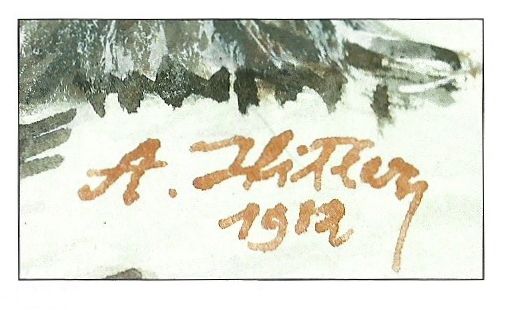
Adolf Hitler's signature as seen on the painting |
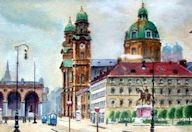
Another church depiction by Adolf Hitler
|
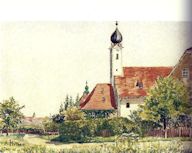
Hitler’s painting of a southern Bavarian church-1925
|
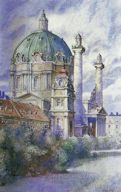
Another view of the Saint Charles's Church by Hitler-1912
|
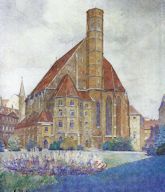
The Minorite Church in Vienna-1910-12
|
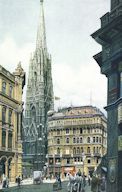
Saint Stephen's Cathedral in Vienna-1910
|

This is the
book by Billy Price on the paintings of Adolf Hitler. It is the only complete
book so far published on the subject, and both of the paintings we offer are
listed and pictured (the very ones!). |

The watercolor of the Vienna church as seen in Billy Price's book on Hitler's art |
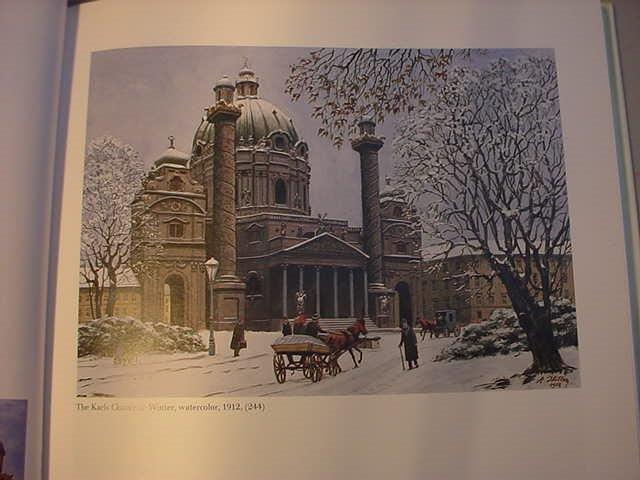
Another picture from Price's book on the art of Adolf Hitler |
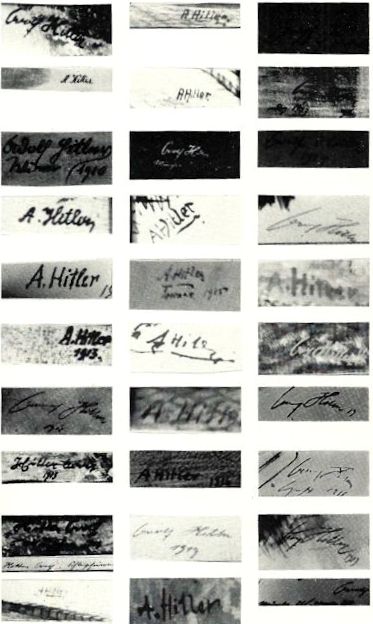
Hitler’s signature changed over the years. Authentic watercolors by him have been seen with several of his varied signatures (No two were ever alike.). Please understand that not all the signatures pictured in this image are from paintings, but they are from Billy Price's book Adolf Hitler: The Unknown Artist. |
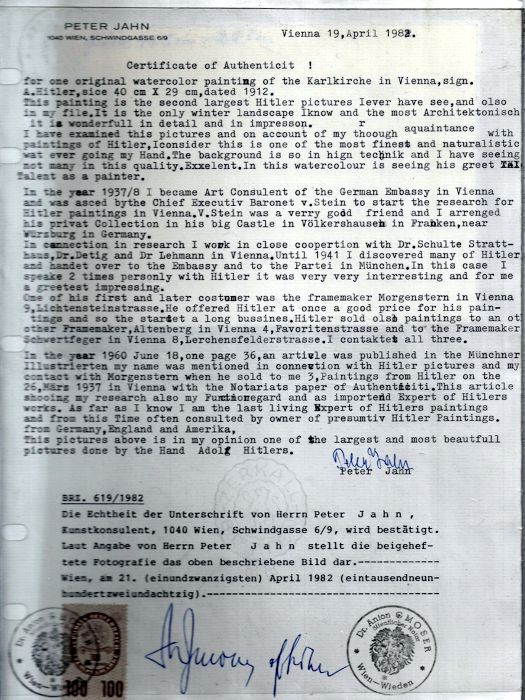
| 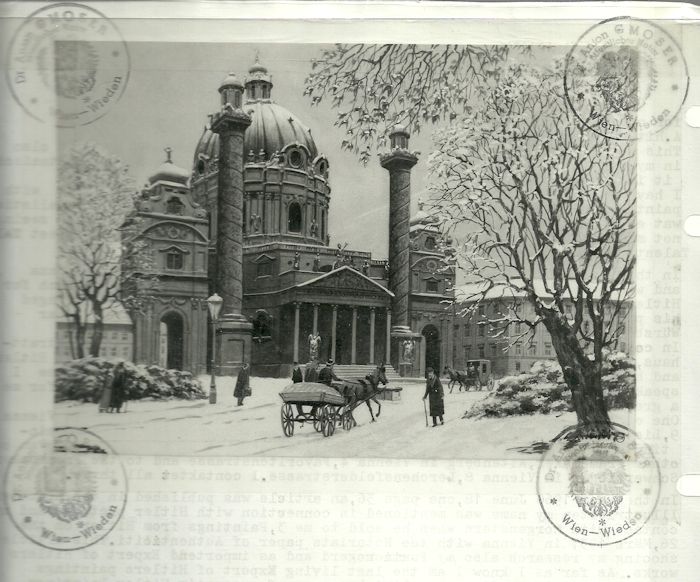
Here is the picture of the painting with notary seals secured to the back of the official statement by Peter Jahn
|
Here is the expertise and certificate of authenticity by Peter Jahn in reference to this watercolor by Adolf Hitler. Peter Jahn, along with Dr. August Priesack, were the only recognized authorities able to accurately authenticate Hitler paintings. Here in rather broken English Herr Jahn says unalterably that the Karlskirche in Vienna signed by Adolf Hitler and dated 1912 is authentic and he praises it as the second-largest Hitler watercolor he had ever seen and is wonderful in detail and impression. He goes on to say that he considers it to be one of the finest and most naturalistic ones he had ever personally held. He says the background displays high technical expertise and has not seen many of this high quality (Excellent!). In this watercolor one can see Hitler’s great talent as a painter.
After giving a short narrative on his life and career, he goes on to say that this picture is, in his opinion, one of the largest and most beautiful works done by the hand of Adolf Hitler.
The statement is with the signature and official stamps of a notary who notarized Peter Jahn's signature in 1982.
Interesting that Peter Jahn did this statement on April 19, 1982, the day before Hitler’s birthday (Significent?).
|
|
Original Adolf Hitler Watercolor of St. Charles’s Church With
Official Provenance and Expertise (Item ART 17-23; AH 28-14; SPECIAL ITEM)
|
| DESCRIPTION: This is the other watercolor painted by Adolf Hitler that we recently obtained. This is the second one mentioned in the article above in the description of the canvas of the castle of Neuschwanstein. We mentioned in that narrative that there were certain buildings and other pieces of architecture that Hitler truly admired and often painted, and this magnificent depiction of Karl’s Church in Vienna was certainly his favorite subject of all. It shows up in both his sketches and paintings several times among the ones that were found. This piece we offer is a full-blown precious watercolor in all its glory. We have mentioned in the article above that only two experts have had proper credentials for authenticating Hitler watercolors and drawings. They are the late Dr. August Priesack and the late Peter Jahn and were the last surviving experts after the war to honestly authenticate a Hitler painting and such expertise from either man is the singular best authentication and support that any purported Führer art piece can carry. Others have also claimed that they can offer authentication. One such ‘expert’ that I would rather term an “X-Spurt” is Herr Hans Horvath also from Vienna. He has built for himself a completely undeserved reputation as an expert in National Socialist paraphernalia and art. In actuality he is a furniture restorer and perhaps he is good at that trade, but in the role of an authority on Hitler art, I think he had better stick to the sandpaper and glue pot. So, in essence, the singular recognized experts in this field remain the late Dr. Priesack and the late Peter Jahn: all others must be taken with skepticism.
The numerous Hitler watercolors and oils that show up are legion, and serious collectors invariably believe only in the ones that bear the Priesack or Jahn credentials. We have explained much about this in the article above regarding the magnificent Schloss Neuschwanstein watercolor. The Karlskirche in Vienna as seen in our accompanying picture just above is also like the other one—accompanied with a provenance and expertise by none other than Peter Jahn with a letter of positive authenticity dated April 19, 1982. According to Jahn, this painting, like the castle rendering, was also one of the largest Hitler watercolors he’d ever seen. The size is 15.75 x 11.5 inches. This is absolutely in my opinion as well, one of the most detailed and crisp examples of Hitler’s work ever located and offered. It is definitely done with watercolor and gouache, boldly signed and dated “1912.” It is in fine condition throughout. The great architectural technique is superb and the people in the depiction are somewhat substantial. Hitler, jokingly perhaps, often said that his paintings could easily be recognized by their “unreal people;” however, the incredible attention to detail in his landscapes, city scenes, and architectural renderings absolutely abound in realism while unfortunately less apparent in his handling of the human figure. It is obvious in his works that he reached for majesty in some of his art, but he also pictured simple Germanic country scenes, as well. For him, the great structures such as the Pergamon Altar and the Parthenon, both of ancient Greece, and the ancient Roman Pantheon, symbolized for him the dimension and glory of the race he considered the founders and builders of Western civilization—the Aryans. The monumental cathedral constructions of the medieval period, the palaces of the Renaissance and the neoclassical structures of the 19th century were as he often said, “expressions of a cultural community, a heritage to be preserved and perpetuated.” Why did Hitler the purported atheist paint churches and cathedrals? Why indeed? Well first of all, the dubious atheist contention comes from the writings and verbal utterings of the “court historians” who seek always to slander him to the fullest with pompous insolence bordering on superciliousness. They seem duty bound with their chosen agenda to attack every vestige of the man’s very being. Hitler was certainly no atheist. He was raised a Catholic and never at any time renounced his faith. In his book Mein Kampf he proclaimed his Christianity and in numerous verbal pronouncements he spoke of his belief in an “Almighty Creator.” Yes, to some extent, he harbored the anticlerical belief that the church in Rome wielded too much power over its faithful adherents; he disdained “churchology” believing God lives within the soul of man and determines his destiny. He was always in favor of “positive Christianity.” He said in a 1922 speech, “My feelings as a Christian point me to my Lord and Savior as a ‘Kämpfer [“fighter”].” In a 1928 speech he said, “We tolerate no one within our ranks who attacks the idea of Christianity . . . in fact our movement is Christian!” So perhaps this is why he so often portrayed the glory and majesty of churches, abbies, and cathedrals in his paintings both in Germany and Austria. The Karl’s Church in Vienna was, as we said, one of his favorite-subject paintings not only because of its beautiful architectural value, but probably because his youth was spent in the study and admiration of famed saints of the church—as any good altar boy would be proud to do. His appreciation of Saint Charles Borromeo, the Patron of the Baroque, was one of the greatest reformers of the 16th century. In 1713, one year after the last great plague epidemic, Charles VI, Holy Roman Emperor, pledged to build a church for his namesake patron Saint Charles Borromeo, whom was revered as a healer for plague sufferers. Mr. Billy Price’s book Adolf Hitler: The Unknown Artist depicts numerous churches that were painted by Adolf Hitler. It seems it was his most preferred subject matter and obviously, this says something at least about his very nature and his spirituality. He actually portrayed Karl’s Church in many different views—front, back, sides—over a period of time and he found during his Vienna period of painting that the depictions of this building sold by far the best to the public whom he at that time desperately sought to sell to. But as to the several churches that he artfully depicted, we know this one by far is the absolute finest! Its brilliance and clarity stand out like a beacon shedding the true artistic light that now goes far to illuminate the intense interest that the future Führer had in all things religious when he was young. It now looms obvious and can be plainly seen in this magnificent watercolor that this must be called a “very significant work” and we know it was painted by this amazing artist whom the autochthonous plebian writers call a “house painter” in their ever-dubious inflammatory writings. So, here is what I would dare to call a “masterpiece” with ironclad provenance and expertise by one of the only two authorities recognized in the art circles for Hitler paintings. This is a golden opportunity to make a very wise purchase that can only increase in value in a very short time. Already, a watercolor painted by Hitler was reported to bring almost $15,000 in an auction on or about April 23, 2009. But, this painting was in my estimation very dismal and dark and reportedly had no letters or documents of authentication or any provenance. Actually, I didn’t even think it was Hitler’s style at all! This story is repeated over and over every year that goes by. The mere mention of anything that Adolf Hitler owned or produced seems to appeal to those who for any reason are so fascinated with him as to loosen their pockets in a heartbeat if the chance to buy something no matter how loose the connection is or how much actual authentication is provided (Barnum was obviously right!). This dubious canvas that brought nearly the $15,000 was sold in England by Mullock's Specialist Auctioneers & Valuers in Shropshire. So I repeat again that only the expertise of Dr. Priesack and/or Peter Jahn is accepted today, Otherwise you “pays your penny and takes your chance.” In closing let it be said that if you ever wanted to own the ultimate Hitler item actually produced by this phenomenal man here is the unique opportunity that will be before you in all probability only once!
PRICE: SOLD
|

|
BERLIN—A 1914 watercolour by Adolf Hitler fetched 130,000 euros ($161,000) at auction in the German city of Nuremberg on Saturday, the auctioneers said. The buyer was a private person from the Middle East who attended the sale in person, said Kathrin Weidler, head of the auction house. She said there had also been inquiries from Asia and America.
The painting, entitled "Standesamt und Altes Rathaus Muenchen" (Civil Registry Office and Old Town Hall of Munich), is one of about 2,000 works that Hitler painted between about 1905 and 1920 as a struggling young artist. Asked before the auction whether it was tasteless to auction the Nazi dictator's works, Weidler said complaints should be addressed to the sellers—two unidentified German sisters in their 70s. Weidler said the vendors had decided to donate around 10 percent of the proceeds to a charity that helps disabled children.
Weidler said the original handwritten bill of sale, dated Sept. 25, 1916, had come with the painting and was a rarity for Hitler's art. That also explained the relatively high selling price, she said. |
Hitler Art is the New Rage Among Collectors
|

|
This work titled “Siegfried” by August Bischoff was a Hitler favorite and is expected to bring a huge price possibly in the six-figure area of $150,000.00, or more?
Adolf Hitler’s favorite artists and artwork, promoted throughout Nazi Germany and shunned as a result by the world for decades, are now on fire, with art collectors in America and Europe paying more than $150,000 for certain pieces such as paintings, tapestries, and bronze statuary. The general consensus is that there’s a vibrant market here.
Marius Martens, a Dutch art dealer, said that art from Karl Walther or sculptor Georg Kolbe, whom Hitler liked and whose work he displayed in Third Reich buildings, has finally caught the eye of collectors because the World War II period is now popular. Martens said that the popularity of Hitler’s favorite artists sprang to life in just the last 12 months.
“Last year, the market was awakened by the sale of a painting by Karl Walther for 23,000 euro. It was an extremely scarce piece as it once hung in the New Chancellery of Adolf Hitler,” he said. “It seems now that this was not a one-off occasion. Recently works of other artists popular in the Third Reich have been sold for considerable prices,” he added. “Almost 70 years after World War II, more and more people see this art from a purely historical perspective. Although the artworks originate from an extremely tragic period, they should not be hidden or destroyed. This is an opinion shared by several museums, seeing the rising number of exhibitions of this art and the number of visitors,” said Martens. He added that as the World War II generation dies off, their period becomes history. “The driver is time. Just like no well-thinking human being bought a portrait of Napoleon in 1820, short after he destroyed Europe,” said Martins. “In the coming 10 years everybody who lived in the war will die: this means that living-past will change into history.” |
|
| 
Their conception of our Christ
|

|

Murder
|

Self-portrait of modern artists???
|

|
| 
|

Motherhood
|

|

Silver wedding anniversary
|

|
| 
War memorial; German soldiers depicted as rodents
|

|

|

|

Their depiction of the "Passion"
|
| 
Cricifix
|

True sacred art of Germany
|

Wolfgang Willrich's depiction of an elderly man
|

Art as it should be
|

Art of the West
|
|
|
Book Säuberung des Kunsttempels (Purging the Temples of Art) by Wolfgang Willrich.
The German subtitle translates to: “A Political Art Fighting Trieste on the Cleaning Up of German Art in the Spirit of Nordic Art” (Item ART 17-24; RAREBOOK 2-4; NSD 18-52)
|
DESCRIPTION: STOP! . . . and hopefully reflect on the findings of the N.S. association for the preservation of Aryan culture. What follows is its description and explanation of what constitutes degeneracy in art. This is one of the rarest and most-sought-after books ever published in the Third Reich. Produced in the year 1937 (a banner year for the Third Reich), there was at that time an exhibition in Berlin known as Die Ausstellung “Entartete Kunst” translated as The Degenerate-Art Exhibition. It was actually organized by Adolf Ziegler and the “Party” (The National Socialist German Workers’ Party) and ran from July 19 to November 30, 1937. The exhibit presented 650 so-called “works of art” from German museums and was presented in counterpoint and contrast to the current great German art exhibition. The day before the exhibition started, Hitler delivered a speech declaring merciless war against cultural disintegration by attacking chatterboxes, dilettantes, and art swindlers. Degenerate art was defined as works that insult traditional German mores and cultural tradition or destroy or confuse natural form, or simply reveal a complete absence of adequate manual and artistic skill. One million people attended the exhibition in its first six weeks. A U.S. critic commented, “There are plenty of people, true art lovers in Boston and throughout the U.S., who will stand with and absolutely side with Hitler in this particular purge.” Hitler had a passionate critique of modern art and its practitioners. He (and this author) perceived them to be incompetents, cheats, and madmen! A commission was formed with Adolf Ziegler as its chairman and toured various art museums in several cities seizing 5,238 so-called art pieces that they deemed degenerate showing qualities such as decadence, weakness of character, mental disease, and racial impunity. The commission especially focused on works by ‘artists’ mentioned in avant-garde publications and was aided by some vehement steady opponents of modern art such as the famed art master of the realistic art form, Wolfgang Willrich. Many of the lowest and horrid canvases by such dubious luminaries such as Georg Kolbe, Paul Klee, Marc Chagril, and (“UGH!”) Pablo Picasso abound. About 20,000 persons per day attended the exhibition. On the walls accompanying the oil and watercolor trash were signs proclaiming sentiments and slogans, for example:
*Insolent mockery of the divine (and Christian)
*Revelation of the Jewish racial soul
*Insult to German womanhood
*The ideal–Cretin and Whore
*Deliberate sabotage of national defense
*German farmers–a Yiddish view
*Madness becomes method
*Nature as seen by sick minds
*Even bigwigs dared to call this trash the art of the German people.
All in all, the idea was well carried that modernism was a conspiracy by those who would harm German decency. After the exhibition closed in 1937, the REAL artist, Wolfgang Willrich, put together the volume we now offer. It is basically a summation of the Entartete Kunst exhibition with running commentary from this man who is possibly the greatest artist in realism that Germany had seen since Albrecht Durer. Willrich had published several books that graphically portray the nobility and beauty of the Aryan race and Germans in particular. His illustrations are so vivid, so real, as to be practically spiritual in the physiognomy displayed. No Nordic person who is conscious of his beginnings can look upon Willrich’s painting of Germanic peasant folk, the children, the aged, the soldiers, sailors, airmen, and  elite troops without a special pride swelling up in the breast. And of course alternatively the traditional enemy experiences the same emotion that the vampire experiences when suddenly confronted by a crucifix! No art critic or historian could have been better chosen to do a review of the exhibition from the standpoint of critique. Here was Herr Willrich the man considered the shining light of beautiful renderings of humanity looking at the dark side of art, the stuff straight from Hell! The book contains about 170 pages with 64 illustrations. You will notice the Irminsul in the center of the opening title page indicating that this might have been an Ahnenerbe publication and it was published by the J. Lehmanns Verlag in Berlin 1938. This company published several Ahnenerbe-certified books in the 1930s. The book is in fine condition with original dustcover preserved by the former collector who covered it with plastic. Its size is 6 ½ x 9 inches and I assure you it is a very highly sought-after volume throughout Europe, especially in Germany and Austria where a revisionist awakening appears to be taking hold. It is one of the absolutely rarest N.S. books extant today. In 50 years, I have not seen another available. The price is most reasonable considering its content and its extreme rarity. elite troops without a special pride swelling up in the breast. And of course alternatively the traditional enemy experiences the same emotion that the vampire experiences when suddenly confronted by a crucifix! No art critic or historian could have been better chosen to do a review of the exhibition from the standpoint of critique. Here was Herr Willrich the man considered the shining light of beautiful renderings of humanity looking at the dark side of art, the stuff straight from Hell! The book contains about 170 pages with 64 illustrations. You will notice the Irminsul in the center of the opening title page indicating that this might have been an Ahnenerbe publication and it was published by the J. Lehmanns Verlag in Berlin 1938. This company published several Ahnenerbe-certified books in the 1930s. The book is in fine condition with original dustcover preserved by the former collector who covered it with plastic. Its size is 6 ½ x 9 inches and I assure you it is a very highly sought-after volume throughout Europe, especially in Germany and Austria where a revisionist awakening appears to be taking hold. It is one of the absolutely rarest N.S. books extant today. In 50 years, I have not seen another available. The price is most reasonable considering its content and its extreme rarity.
PRICE: $700.00; At this point in time it is probably unique!
|
|
|
|
Iron Plaque Depicting the Teutonic Knight’s Defending Christianity (Item ART 17-25)
|
| DESCRIPTION: This 4- x 6-inch iron plaque goes far to illustrate the truth about the National Socialist relationship with Christianity that has right along been held up to the distortions of the Left and the Kosher Conservatives in America and Britain. The victors of WWI felt compelled to smear the Germany of Adolf Hitler’s religious following. Adolf Hitler is still quoted as calling upon God to help and defend that nation. He also praised the Deity in many of his speeches. National Socialist Party never waged war against the Protestant or Catholic churches or the liturgy. In fact, the N.S. government sponsored and actually financed the building of churches all over the land. Yes, of course they did not support religions that were considered alien to the German psyche or ancient traditions. In addition to supporting these orthodox religious groups, there was a movement within the German Evangelical Church called the Deutsche Christen (German Christians). Once the NSDAP came to power this group sought the creation of a national ‘Reich church’ led by Pastor Ludwig Müller, who closely followed and came to practice the teachings of the famed Dr. Martin Luther, a revival of the old conservative values and ethics. The faith observed in Imperial Germany was beckoning and now there would be a Christian Germany once more—the Führer promised this! The German Christian Movement was officially formed in 1932—before Hitler became chancellor—and brought together a number of groups that espoused this nationalistic theology that stressed the saving character of a strong state and the church, as part of the state. The religionists and clergies would march alongside the German people to seek to bring about an earthly paradise as Karl Barth described it. The church was part of the state and the state is eternal and equal to the Bible in expressing God’s will. The Führer is commissioned to be at the command of God with Nietzsche, Rosenberg, Pastor Dinter, and Richard Wagner as the spiritual prophets. The German Christians moved to restore the true ways and commands of Martin Luther and, yes, Hitler stood next to Christ as the Savior and leader of all Germans. The true manifestation of the divine in history, Hitler was considered the revelation of God’s will to men. History had given Germany another latter-day Messiah. The church was not only a religious body, but also a bulwark of morals and German tradition. What an impressive sight to see more than a hundred young men march to church on Sunday in the uniforms of the SA, SS, Hitler Youth, and the political leader corps as they sat in the front pews. Bands in party uniforms played ancient and revered musical hymns such as Luther’s “A Mighty Fortress is Our God.” These spectacles drew many to the churches to witness this nationalistic splendor. We know that the Vatican signed the famed concordat because it to a great extent shared the views of the NSDAP. Why? Because of the NS Party’s campaign against the evils of Communism. This concordat was signed on July 20, 1933. This was supported by most of the 20 million Catholics in Germany. Today, if one wants to believe the scurrilous dribble that one sees on the various web sites you will see various poisonous vilifications of the German Christian Movement. But I address my narrative to those who are sick and tired of the lies and slanders and wish to momentarily at least ‘listen to a different drummer.’ The plaque depicts a stalwart Teutonic knight who nobly stands in defense of either a saint or an angel. The religious figure stands pious clutching a crucifix and a halo is upon her head while the warrior stands guard with his crusader-type shield and sword. The plaque was cast in 1934, the second year of Hitler’s ascension to power and we feel it is an icon to the German Christian Movement. The figure might be Saint Mary because the Teutonic Knights were the “Order of the German House of Saint Mary in Jerusalem.” This order of noble knights was formed to guard and aid Christians on their pilgrimages to the Holy Land. It was formed at the end of the 12th century. They fought against the Russians and the Poles. Is it unreasonable that the Teutonic Knight guards Mary in this scene? The plaque is signed by an artist named Encke and between the numerals “19” and “34” is the symbol of the Handworkers’ Association; this is in the depiction of a hammer. This nice piece of Third Reich art is not only quite artistically beautiful but also prodigiously important and carries a revisionist view of the Hitler Reich that is in obvious evidence. This is one of the greatest of the many important historical finds we have ever offered on our site.
PRICE: SOLD
|
[Return Home]
Contact Us
Please refer to item designator in parentheses in all correspondence.
Please E-mail for any additional information you may need.
If you prefer, contact 'Germania' at PO Box 68, Lakemont, GA 30552
or call at 706.782.1668.
Please! do not call during the wee hours of the morning. The best time for calling us is between 9 and 11 am and between 9 and 11 pm
eastern time.
| | | | | |

![]()




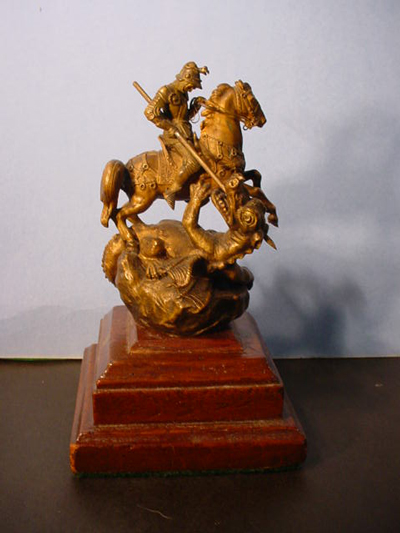



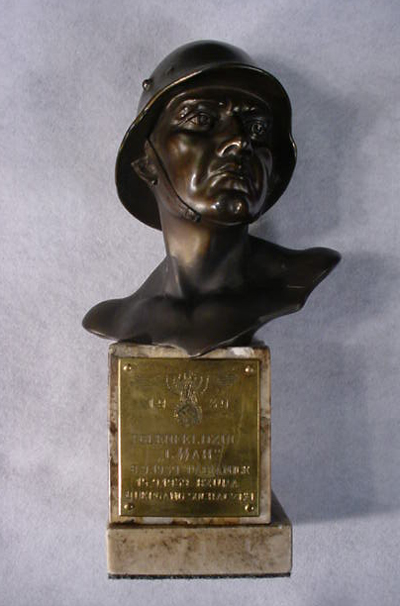
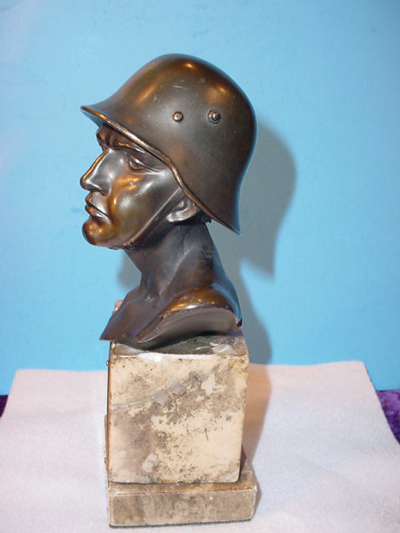


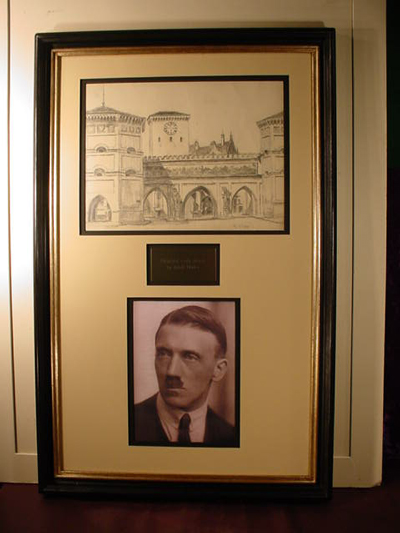
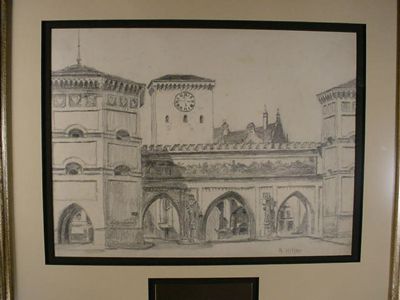
 ). This is the typical type of thing that was produced in one of the departments of the
). This is the typical type of thing that was produced in one of the departments of the  -Ahnenerbe, the Ancestral Heritage Foundation. We will not go into an explanation of the functions or history of this learned group of historians and early revisionists because if you read any or all of the narratives about the Ahnenerbe Stifftung you will know that this was a foundation set up by the Reichführer-SS Heinrich Himmler in 1935, and was an Ancestral Heritage Research and Teaching Society or Ahnenerbe Forschungs und Lehrgemeinschaft. Much can be learned by going into Google and typing in “Ahnenerbe SS,” and by reading our narratives on the previous pages of this section. Under the teaching aspects of this academically refined organization there was a section that reproduced or re-created various articles from the Aryan Germanic past. Especially researched were the connections made that chronicled the early Germanic use of the swastika and other runic symbols such as the (S) rune that we know became the symbol of the
-Ahnenerbe, the Ancestral Heritage Foundation. We will not go into an explanation of the functions or history of this learned group of historians and early revisionists because if you read any or all of the narratives about the Ahnenerbe Stifftung you will know that this was a foundation set up by the Reichführer-SS Heinrich Himmler in 1935, and was an Ancestral Heritage Research and Teaching Society or Ahnenerbe Forschungs und Lehrgemeinschaft. Much can be learned by going into Google and typing in “Ahnenerbe SS,” and by reading our narratives on the previous pages of this section. Under the teaching aspects of this academically refined organization there was a section that reproduced or re-created various articles from the Aryan Germanic past. Especially researched were the connections made that chronicled the early Germanic use of the swastika and other runic symbols such as the (S) rune that we know became the symbol of the  where two of these configurations were seen side by side. In this necklace we see six groups of amber planchets that are shaped as
where two of these configurations were seen side by side. In this necklace we see six groups of amber planchets that are shaped as  runics as used by the “Black Corps.” Since the Ahnenerbe was a branch of the Allgemeine-
runics as used by the “Black Corps.” Since the Ahnenerbe was a branch of the Allgemeine- this was particularly meaningful to the foundation. Amber had very special meaning to the N.S. mythos as did the oak tree that was also sacred to the ancient and modern Germans. Amber was thought to have mystical powers and the wearing of Bernstein was conducive to health; both physical and mental. Amber or Heilege Bernstein was used in various ceremonies and ceremonial objects of the SS. The Reichsfüherschule (Reich’s Leadership School of the SS) used objects crafted in amber for displays and instruction in Aryan values and perceptions. It truly was to the Teutons the Holy Stone (even though it is not a stone in the usual sense of the word). It’s actually resin, or tree sap, that is millions of years old. Over the many centuries this material fossilized from the ancient trees and formed through a natural polymerization a hard formation with a beautiful, soft, cream hue in colorization. We have visited the story of amber in other places on our site. We have also explained the reverence that was given to it by the Teutonic people through the ages. The ancient Romans believed that amber protects one from evil forces and heals from illness. The Germanics believed that it protected from all sorts of evil spells. They considered jewelry crafted from it would often be an antidemonic amulet or necklace like this one we offer. It was also believed that amber beads hidden in a baby’s clothes would counteract any malicious forces. Bernstein was always a symbol of truth and integrity and its soft, but strong visage is pleasing to the person viewing it and fills them with admiration and awe. That is precisely why the occasional Mein Kampf book by Adolf Hitler is found with a cover fashioned from amber. See the one we obtained and feature at AH 26-26. Also, see the "Presentation Bernstein Box" presented to SS-Obergruppenführer, Hans Adolf Prutzmann, at SS 35-8. This necklace is about 14 inches long and the fittings for fastening it together have been replaced. The original was quite worn and did not any longer have closures effective enough; the new one is exactly like the old. Among SS-Ahnenerbe articles and general
this was particularly meaningful to the foundation. Amber had very special meaning to the N.S. mythos as did the oak tree that was also sacred to the ancient and modern Germans. Amber was thought to have mystical powers and the wearing of Bernstein was conducive to health; both physical and mental. Amber or Heilege Bernstein was used in various ceremonies and ceremonial objects of the SS. The Reichsfüherschule (Reich’s Leadership School of the SS) used objects crafted in amber for displays and instruction in Aryan values and perceptions. It truly was to the Teutons the Holy Stone (even though it is not a stone in the usual sense of the word). It’s actually resin, or tree sap, that is millions of years old. Over the many centuries this material fossilized from the ancient trees and formed through a natural polymerization a hard formation with a beautiful, soft, cream hue in colorization. We have visited the story of amber in other places on our site. We have also explained the reverence that was given to it by the Teutonic people through the ages. The ancient Romans believed that amber protects one from evil forces and heals from illness. The Germanics believed that it protected from all sorts of evil spells. They considered jewelry crafted from it would often be an antidemonic amulet or necklace like this one we offer. It was also believed that amber beads hidden in a baby’s clothes would counteract any malicious forces. Bernstein was always a symbol of truth and integrity and its soft, but strong visage is pleasing to the person viewing it and fills them with admiration and awe. That is precisely why the occasional Mein Kampf book by Adolf Hitler is found with a cover fashioned from amber. See the one we obtained and feature at AH 26-26. Also, see the "Presentation Bernstein Box" presented to SS-Obergruppenführer, Hans Adolf Prutzmann, at SS 35-8. This necklace is about 14 inches long and the fittings for fastening it together have been replaced. The original was quite worn and did not any longer have closures effective enough; the new one is exactly like the old. Among SS-Ahnenerbe articles and general  items, this has to be one of the most exotic and rare items we have practically ever offered or seen. This is for the advanced collector and historian.
items, this has to be one of the most exotic and rare items we have practically ever offered or seen. This is for the advanced collector and historian.